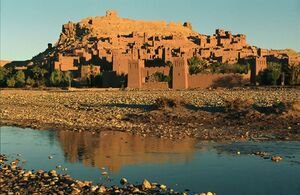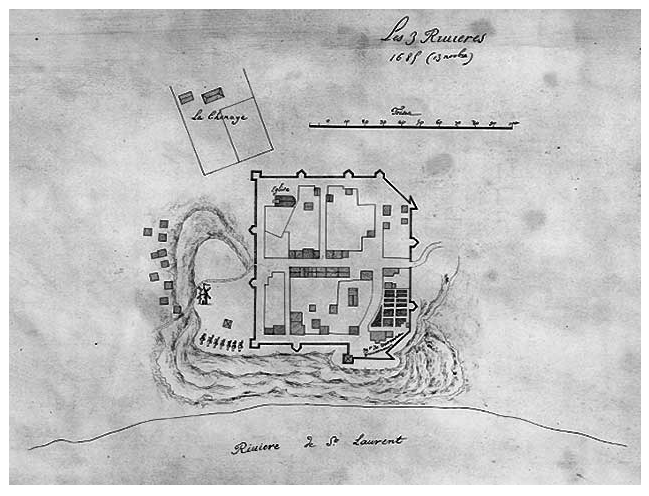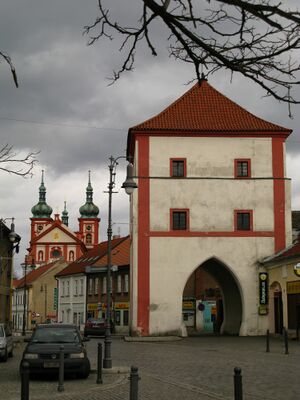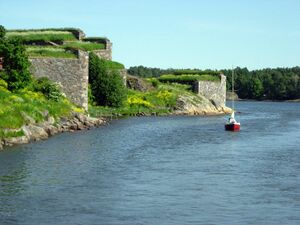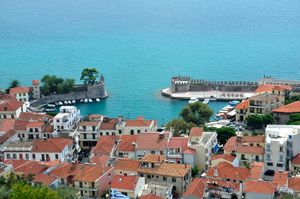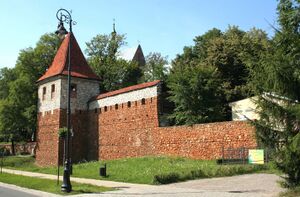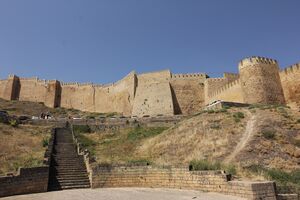قائمة المدن بأسوار دفاعية
المدن التالية لديها أو كان لديها تاريخيًا أسوار دفاعية.
أفريقيا
الجزائر
مصر
إثيوبيا
ليبيا
مالي

المغرب
- أكادير
- آيت بن حدو
- أصيلا
- أزمور
- الدار البيضاء
- شفشاون
- الجديدة
- الصويرة
- فاس
- القصر الكبير
- القصر الصغير
- العرائش
- مراكش
- مكناس
- مولاي عبد الله
- مولاي إدريس
- ورزازات
- وجدة
- الرباط
- آسفي
- سلا
- صفرو
- طنجة
- تارودانت – أفضل مدينة مسورة محفوظة في المغرب[1]
- تازة
- تطوان
- تزنيت
النيجر
- زندر التي اشتهرت بأسوارها، ولا تزال بقاياها مرئية حتى اليوم.
نيجيريا
تونس
الأمريكتان
كندا
| المكان | الحالة | الصورة | ملاحظات |
|---|---|---|---|
| هاليفاكس، نوفا سكوشا | مدمرة | 
|
تم بناء الجدران الدفاعية في عام 1750 للدفاع عن مستوطنة هاليفاكس (وسط هاليفاكس الحالي). كما تم بناء خمسة حصون حول الجدران الدفاعية للمدينة، بما في ذلك سلف حصن جورج.[2] تم إزالة الجدران في ستينيات القرن الثامن عشر.[2] |
| لويسبورغ، نوفا سكوشا | مدمرة (1760) أعيد بناؤها جزئيًا (ستينيات القرن العشرين) |

|
كانت لويسبورغ مستوطنة محصنة تقع جنوب المجتمع الحالي للويسبورغ. كانت المستوطنة عاصمة للمستعمرة الفرنسية إيل-رويال من عام 1713 إلى 1758. بعد استيلاء البريطانيين على لويسبورغ، تم تدمير تحصيناتها الدفاعية. وخلال ستينيات وسبعينيات القرن الماضي، أُعيد بناء ربع المستوطنة التاريخية ضمن مشروع إعادة إعمار من قبل حكومة كندا، بما في ذلك أجزاء من جدرانها الدفاعية. |
| مونتريال، كيبيك | مدمرة؛ بقايا مكشوفة جزئيًا | 
|
تم الانتهاء من بناء الجدران في عام 1744، وكانت تحيط بمعظم مونتريال القديمة. تم هدم الجدران في بداية القرن التاسع عشر، على الرغم من أن بعض أساساتها تركت مدفونة. في وقت لاحق، كُشف عن أساسات الجدران في شامب دي مارس وفي متحف بوانت-آ-كايير. |
| مدينة كيبيك، كيبيك | سليمة | 
|
تحيط معظم كيبيك القديمة في الجزء العلوي من المدينة. بدأ بناء الجدران في تسعينيات القرن السابع عشر، مع تحسينات وترميمات إضافية خلال القرون التالية. يشكل الجزء الجنوبي من الجدران جزءًا من قلعة كيبيك، التي تُستخدم كموقع عسكري من قبل القوات المسلحة الكندية وكإقامة رسمية للملك والحاكم العام لكندا. |
| تروا ريفيير، كيبيك | مدمرة | 
|
كانت أول مستوطنة دائمة في منطقة تروا ريفيير، و |
| فيريلاند، نيوفاوندلاند ولابرادور | مدمرة؛ بقايا مكشوفة جزئيًا | 
|
فيريلاند، التي تأسست في عام 1623 من قبل إدوارد وين، كانت في وقت ما المستوطنة الرئيسية في مقاطعة أفالون. خلال فترة وجودها، كانت البلدة محاطة بخندق وساتر وجدار باليساد، مع أبراج على الزوايا. ومع ذلك، تم تدمير البلدة من قبل الفرنسيين خلال حملة شبه جزيرة أفالون. في أواخر الثمانينيات، بدأت الحفريات الأثرية في الموقع وكشفت منذ ذلك الحين عن بقايا العديد من المباني والخندق وشارع مرصوف بالحصى والعديد من المعالم الأخرى.[4] |
| كاناواكي، كيبيك | مدمرة | 
|
تم بناء حصن في كاناواكي من قبل مبشرين يسوعيين في عام 1725 لحماية بعثتهم وقرية إيروكوا المجاورة. كان حصن البعثة، حصن دو سول-سانت-لويس، يحتوي على أربعة أبراج، بنيت من الحجر مع أبراج حراسة على الأطراف. كانت القرية محاطة من جميع الجوانب بجدار باليساد (أعيد بناؤه من الحجر في عام 1747)، يتكون من ستة أبراج وبرج نصف واحد. كانت هناك ثلاث بوابات كبيرة تخترق جدران القرية، بالإضافة إلى بوابة صغيرة وثلاث بوابات خلفية. الآن، يشغل موقع الحصن مهمة سانت فرانسيس كزافييه، وتبقى أجزاء من الجدران في تلك المنطقة. |
تشيلي
كولومبيا
كوبا
جمهورية الدومينيكان
- سانتو دومينغو كانت مدينة محصنة من القرن السادس عشر حتى أوائل القرن العشرين. لا تزال أجزاء من الجدار مرئية في المنطقة الاستعمارية. واحدة من البوابات الرئيسية محفوظة بشكل جيد جدًا وسميت منذ قرون "بوابة الكونت" تكريمًا لكونت بينالبا الذي أوقف غزو ويليام بن وروبرت فينابلز خلال حصار سانتو دومينغو.
المكسيك
- كامبيتشي - لا تزال معظم الجدران المحيطة بالمدينة القديمة موجودة
- مايابان (أطلال المايا)
- مريدا، يوكاتان (هدمت في أواخر القرن التاسع عشر، لكن بعض الأجزاء والبوابات المقوسة بقيت)
- مدينة مكسيكو[بحاجة لمصدر]
- تولوم (أطلال المايا)
- ڤيراكروز (تم هدم الجدران في القرن التاسع عشر، ولكن لا يزال حصن قائم)[5]
بنما
الحي القديم في مدينة بنما (جزء من الجدار لا يزال موجودًا)[6]
بيرو
بورتو ريكو
- سان خوان القديمة - تغطي المنطقة التاريخية لسان خوان القديمة كامل مساحة المدينة المسورة سان خوان باوتيستا، والمعروفة أيضًا باسم مفتاح جزر الهند، عاصمة بورتو ريكو الاستعمارية. تشمل المنطقة قلعة سان فيليبي ديل مورو، قلعة سان كريستوبال، لا فورتاليزا، إل كانيويلو، وغيرها من الحصون التي تشكل جزءًا من أسوار سان خوان القديمة، والتي لا تزال تحيط بنسبة خمسة وسبعين بالمئة من المدينة الاستعمارية.
الولايات المتحدة

- بوسطن، ماساتشوستس، كانت تمتلك جدارًا دفاعيًا وبوابة عبر بوسطن نيك، النقطة الوحيدة التي تربط المدينة بالبر الرئيسي، من عام 1631 حتى نهاية القرن الثامن عشر.
- تشارلستون، كارولاينا الجنوبية كانت مدينة مسورة من تسعينيات القرن السابع عشر حتى عشرينيات القرن الثامن عشر. لا يزال جزء من الجدار، يسمى بطارية نصف القمر، مرئيًا في زنزانة السجن القديمة لمبنى التبادل القديم.
- سانت أوغسطين، فلوريدا، بدأ الإسبان في بناء Cubo Line في عام 1704 - متصل بقلعة سان ماركوس ومحيط بالمدينة. توضح خرائط القرن الثامن عشر الجدران التي كانت تحيط بجميع سانت أوغسطين.[7]
- نيو أورلينز، لويزيانا، تم تخطيطها في عام 1718 كمدينة مسورة. كان الجدار موجودًا خلال معركة نيو أورلينز، لكنه كان في حالة سيئة لدرجة أنه لم يُستخدم.[8][9]
- مدينة نيويورك، في القرن السابع عشر، كان لدى أمستردام الجديدة جدار دفاعي عبر مانهاتن. وول ستريت سميت على اسم هذا الجدار.[10]
أوروغواي
آسيا
أفغانستان
- بلخ، المدينة القديمة
الصين
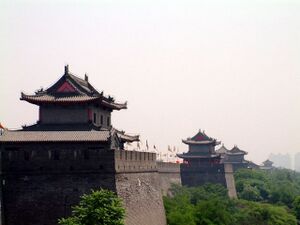
- بكين، انظر سور مدينة بكين. تم هدم العديد من أجزاء جدران بكين خلال الستينيات لفتح شوارع واسعة حول المدينة. كما أن خط المترو يتبع موقع الجدران السابقة.
- شيانغيانغ
- قوانغتشو
- دالي
- شانغتشيو
- جيانشوي
- تشانغجياكو، انظر Wanquan District
- تشاو تشينغ
- Guangfu Ancient City
- شينغتشنغ
- لياو تشينغ
- كايفنغ
- تشيانسوه في Huludao
- داتونغ
- مقاطعة دا مينغ
- حصن يونغتاي
- جينغتشو
- مدينة كولون المحاطة بأسوار، مستوطنة سابقة في هونغ كونغ
- نانجينغ، انظر City Wall of Nanjing
- لينهاي
- تشوفو
- تاييوان، انظر Jinyuan District
- بينغياو
- شانغهاي (المدينة القديمة (شانغهاي)) – دُمرت إلى حد كبير في عام 1912، ولم يتبقَ سوى شظايا.
- سونغبان
- شيآن – المدينة ذات الأسوار المحفوظة جيدًا والخندق المائي، وهي الآن مزار سياحي يشمل حدائق صغيرة تحيط بمنطقة حديثة مزدحمة في المدينة.
- تشنغدينغ
- حي يوانتشو في جوييوان
- القرى المحاطة بالأسوار لا تزال موجودة في الصين القارية وهونغ كونغ.
الهند
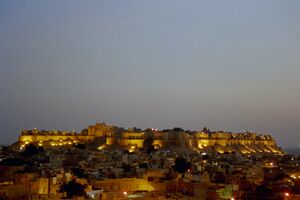
- آغرا
- أحمد آباد
- أمارافاتي
- أمريتسار
- داتيا
- دلهي
- حيدر آباد
- جايمبور
- جايسالمر
- جودبور
- لكناو
- مومباي (المدينة القديمة بومباي)
- رايغاد
- أودايبور
- وارانجال
- تشيناي
- ماهو
- بادامي
- أيهولي
- كانشيبورام
- مادوراي
- بيلور
- هاليبيدو
- تيروفانامالاي
- سريرانغاباتنام
- كولهابور
- سورات
- بارودا
- إندور
- جوالير
- غودا
- مرشد آباد
- كارناسوبارنا
- نابادويب
- تامرلپتي
- بهوفانيشوار
- بوري
- خاجوراهو
- فارناسي
- جانسي
- فيزآباد
- جيا
- باتليبوترا
- كانغرا
- تشايراديو
- جامو
- لودهيانا
- باتيالا
- سيرهند
- تشامباوات
- بيتهوراغاره
- بيلاسبور
- شيملا
إندونيسيا
Pakuan Pajajaran، عاصمة مملكة سوندا، كانت محاطة بخنادق وجدران دفاعية. الآن المنطقة جزء من مدينة بوجور الحديثة.
بني سور في القرن الثامن عشر بواسطة هامنكوبونو الأول من مملكة نغيوجياكارتا لحماية العاصمة الداخلية من الهولنديين وأعداء آخرين خلال فترة مملكة ماتارام. اليوم، 96% من الجدار لا يزال قائماً ويعتبر معلماً محلياً.
في 17 فبراير 1745، انتقلت مملكة سوراكارتا إلى غابة جديدة مفتوحة تُسمى قرية سالا، وبنت قصرها الملكي السكني ومنطقة حضرية مع سور بطول 15 كيلومترًا يُعرف باسم "بيتنج كراتون" أو جدار القصر حولها. اعتبارًا من عام 2022، لا يزال 90% من الجدران موجودة.
كانت معروفة كعاصمة سلطنة بنتن. دُمر الجدار بواسطة الهولنديين خلال الفترة الاستعمارية لإنهاء حكم بنتن. بقي حوالي 10% فقط من مظهر الجدار الأصلي.
كانت تروولان عاصمة إمبراطورية ماجاباهيت السابقة. خلال فترة ازدهارها، كانت العاصمة مدينة قديمة بنظام أوروبي منظم (بما في ذلك نظام قنوات للنقل وكذلك طرق كبيرة للنقل الرئيسي). تم بناء الجدار لحماية "كراتون" الداخلية أو القصر الملكي وبعض المواقع المهمة. اليوم، لا يمكن رؤية الجدار بالشكل الأصلي.
إيران
العراق
فلسطين المحتلة
- عكا – تحصينات حديثة من الإمبراطورية العثمانية في القرن الثامن عشر قادرة على تحمل هجوم المدافع. تم ترميم الجدار ويشمل الآن ممشى للسياح.
- يافا
- صفد
- طبريا
لبنان
- بعلبك: لا تزال أقسام من التحصينات العربية (المبنية من حجارة رومانية) مرئية حول الأكروبوليس والبلدة القديمة.
- البترون: تشتهر المدينة بجدار بحري فينيقي بطول 225 مترًا. كما كان هناك قلعة تعود للقرن التاسع قبل الميلاد، لا تزال أجزاء منها مرئية.
- بيروت: تم الكشف عن أقسام من التحصينات الفينيقية والرومانية والقلعة العثمانية في وسط بيروت. لم يتم العثور بعد على الجدران الشهيرة التي بناها فخر الدين الثاني.
- جبيل: تحيط البلدة القديمة جدران من العصور الوسطى، وتقع قلعة عند الحافة الجنوبية لهذه الجدران.
- صيدا: القليل من تحصينات المدينة في العصور الوسطى لا تزال قائمة اليوم، باستثناء قلعة القديس لويس.
ماليزيا
- ملقا – بُنيت بواسطة البرتغاليين بعد احتلال المدينة في عام 1511، وتم هدمها بواسطة البريطانيين في عام 1806. تُعرف محليًا باسم أفاموسا.
باكستان
تقريبًا كل مدينة قديمة في باكستان كانت تحتوي على جدار دفاعي. تم تدمير معظم هذه الجدران من قبل البريطانيين لإعادة تحصين المدن. وتشمل المدن التي كانت محصنة:
- حيدر آباد
- لاهور
- ملتان
- بيشاور
- شيكاربور
- هزرو، منطقة أتك
- كويته
- سيالكوت
- روالبندي
- جوجرات
- جوجرانوالا
- بهيرا
- خدا آباد
- بنو
- تولمبا
- أوتش شريف
- سهوان شريف
- تهته
- كراتشي
- روهري
- منصورة
- بيلا
فلسطين
الفلبين
- سيبو (انظر حصن سان بيدرو)
- مانيلا (إينتراموروس) – محفوظة جزئيًا، وجزء منها تم ترميمه بعد الحرب العالمية الثانية. لا تزال الجدران الأصلية محفوظة جيدًا.
- أولونغابو ("البوابة الإسبانية")
- أوزاميز (فويرتي دي لا كونسيبسيون وديل تريونفو)
- زامبوانجا (انظر حصن بيلار)
كوريا الجنوبية
- دونغني (الآن جزء من بوسان) (انظر حصن دونغني)
- سيول (انظر جدار حصن سيول)
- سوون (انظر حصن هواسيونغ)
- غوانغجو، غيونغي (انظر نامهانسانسونغ)
- غويانغ (انظر بوكهانسانسونغ)
سريلانكا
- جالي (انظر حصن جالي)
- ماتارا (انظر حصن ماتارا)
سوريا
تايوان
- تشانغوا
- تشيايي
- فونغشان (الآن جزء من كاوشيونغ)
- هينغتشون (انظر المدينة القديمة في هينغتشون)
- هسينشو
- ماغونغ
- بولي
- كيموي
- تاينان
- تايبيه (انظر أسوار تايبيه)
- زويينغ (الآن جزء من كاوشيونغ، انظر المدينة القديمة في زويينغ)
بعض المدن الأخرى كانت محاطة بجدران من البامبو الشوكي خلال فترة حكم أسرة تشينغ. [11]
تايلاند
- أيوثايا
- بانكوك – انظر تحصينات بانكوك
- شيانغ ماي – كانت المدينة محاطة بخندق وجدران عندما أسسها الملك منغراي العظيم في عام 1296. تم إعادة بناء الجدران بشكل كبير في أوائل القرن التاسع عشر. لا تزال أجزاء كبيرة من جدران المدينة وبواباتها موجودة حتى اليوم.
- شيانغ راي
- شيانغ ساين
- كامفانغ فيت
- لامبانغ
- لامفون
- لوبوري
- ناخون راتشاسيما
- ناخون سي تامارات
- نان
- فيشاي
- فاياو
- فيمي
- فيتسانولوك
- فراي
- سي ساتشانالاي
- سونغكلا
- سوخوثاي
- سوفانبوري
- ثونبوري
- ويانغ كوم كام
أوزبكستان
ڤيتنام
اليمن
Europe
ألبانيا
النمسا
- آلينتشتايغ
- آمستيتن – ليست محاطة بأسوار ولكن محصنة بخندق وسدود وأبراج بوابات.
- بليبورغ
- بلودينز
- براوناو آم إن
- بريغنز
- بروك أن دير لايثا – محفوظة جزئيًا
- بروك أن دير مور
- دونيرسكيرشن
- دروسندورف
- دورنشتاين
- إبينفورث
- إيفيردينغ
- إغنبورغ
- أيزنشتات
- إينس
- فيرنغ
- فيلدكيرش
- فريدبيرغ
- فريشتات – محفوظة بالكامل تقريبًا
- فريزاخ
- فرونلايتن
- فورستنفلد
- غميند
- غميند في كارينثيا
- غموندن
- غراتس
- غروس-إنزرزدورف
- غوسينغ
- هاينبورغ أن دير دوناو – محفوظة بالكامل تقريبًا (2.5 كيلومتر، 3 بوابات، 15 برجًا)
- هالين
- هال إن تيرول – محفوظة جزئيًا
- هارديغ
- هارتبيرغ
- هاسلاتش آن دير مول
- هايدنرايششتاين
- هرتسوغنبرغ
- هورن
- يودنبورغ
- كيتسبوهل
- كلاغنفورت
- كلوسترنوبرغ
- كنيتلفيلد
- كورنيوبورغ
- كريمس
- كوفشتاين
- لا آن دير ثايا
- ليوبن
- ليونفيلدن
- لينز
- ليتشاو
- مايساو
- مارشغ – بعض الأجزاء محفوظة
- ماوترن – توجد بقايا حصن روماني "فافيانا" على الجانب الغربي من المدينة القديمة.
- ميلك
- مورا
- مورزوشلاغ
- نيو ماركت آم واليرسي
- نيو ماركت
- أوبداخ
- أوبرويلتز
- أوغغاو آم نويسيدلير سي
- أوتنشايم
- بيورباخ
- بوخلار
- بورباخ آم نويسيدلير سي
- رابز آن دير ثايا
- رادفيلد
- رادكيرسبورغ
- رادشتات – محفوظة بالكامل تقريبًا (من القرن 13 إلى 16)؛ 3 أبراج مستديرة (من ثلاثينيات القرن 16)؛ بوابة واحدة
- راتنبرغ
- ريتز
- ريد آم إنكريس
- روتينمان
- روست
- سانكت أندرا
- سانكت فايت أن دير غلان
- سانت بولتن
- سالزبورغ
- شيردينغ
- شايفس
- شلادمينغ
- شراتنتال
- شفاننشتات – المستوطنة محاطة بسد، وفوقه جدار خشبي. يحتوي على جدار قصير بجانب ‘‘برج المدينة’’.
- شتادتشلينينغ
- شتايناخ
- شتاين
- ستراسبورغ
- شتاير
- شتايرغغ
- ترايسماور
- تولن أن دير دوناو
- فيينا – دمرت وأصبحت شارع الحلقة (رينغشتراسه)
- فيلاخ
- فيلس
- فيكلابروك
- فولكرماركت
- فويتسبيرغ
- فايدهوفن أن دير ثايا
- فايدهوفن أن دير إيبس
- فايترا
- فيلس
- فينر نويشتات
- فيلهلمسبيرغ
- فولفسبيرغ
- إيبس أن دير دوناو
- زايسلمور – الحصن الروماني المعاون تم تحصينه مجددًا من قبل بابنبيرغ في القرن العاشر، ولكنه لم يُمنح سوقًا أو ميثاقًا.
- زسترزدورف
- زفيتل
أذربيجان
- باكو تحتفظ بمعظم أسوار المدينة التي تفصل المدينة القديمة التاريخية عن الأجزاء الجديدة من المدينة التي تم تطويرها بعد القرن التاسع عشر.
- شاكي
- شوشا
بلجيكا
| المكان | المقاطعة | متاح الوصول | الحالة | الصورة | ملاحظات |
|---|---|---|---|---|---|
| أرشوت | فلامش برابانت | نعم | بقايا فردية واحدة أو أكثر (حصون، بوابات، أبراج، إلخ) موجودة. | البقايا الأكثر أهمية من التحصينات الوسطى التي كانت تحيط ببلدة أرشوت هي برج يقع على قمة تل جنوب البلدة القديمة، يُطلق عليه اسم Aurelianustoren أو برج أورليانس. | |
| آث | هاينو | نعم | بقايا فردية واحدة أو أكثر (حصون، بوابات، أبراج، إلخ) موجودة. | 
|
تم تحصين مدينة آث عدة مرات. من أقدم التحصينات، لا يزال القلعة القديمة، بما في ذلك برج بربانت، قائمة. مسار بعض الشوارع المحيطة بالبلدة القديمة هو من آثار التحصينات الحصينة في العصور اللاحقة. لا تزال بعض هذه التحصينات موجودة شمال البلدة القديمة، بالقرب من بوليفارد ألفونس دينوبورغ. |
| أرلون | لوكسمبورغ | نعم | بقايا فردية واحدة أو أكثر (حصون، بوابات، أبراج، إلخ) موجودة. | 
|
توجد قلعة صغيرة في مركز البلدة القديمة، في موقع قلعة مدمرة من العصور الوسطى. |
| بيومون | هاينو | نعم | بقايا فردية واحدة أو أكثر (حصون، بوابات، أبراج، إلخ) موجودة. | 
|
لا تزال أجزاء كبيرة من الجدار القديم للمدينة موجودة شرق البلدة القديمة. الجزء الأكثر شهرة هو برج السلمندر القديم، وهو برج حفظ قديم. |
| بانش | هاينو | نعم | أجزاء كبيرة من التحصينات لا تزال سليمة. | 
|
تحتوي مدينة بانش على أكثر جدران المدينة سلامة في بلجيكا. بنيت في عام 1230 ميلادي، يبلغ طولها 2.1 كيلومترًا وتضم حوالي 30 برجًا. كانت هناك ست بوابات، ولكن تم هدمها في القرن التاسع عشر. |
| بوليون | لوكسمبورغ | نعم | بقايا فردية واحدة أو أكثر (حصون، بوابات، أبراج، إلخ) موجودة. | 
|
إلى جانب القلعة المدهشة من العصور الوسطى، لا تزال ثلاثة حصون صغيرة تشبه الأبراج، بالإضافة إلى عدة أجزاء صغيرة من الجدار الستائري، موجودة حول المدينة التي بناها المهندس العسكري الفرنسي فوبان في القرن السابع عشر. |
| بروج | فلاندرز الغربية | نعم | بقايا فردية واحدة أو أكثر (حصون، بوابات، أبراج، إلخ) موجودة. | 
|
من بين تسع بوابات في جدران القرن الرابع عشر، لا تزال أربع قائمة اليوم. كما أن عدة أجزاء من الجدار الأرضي المحصن المحيط بالمدينة لا تزال موجودة. بخلاف برج واحد، لا يوجد أثر للجدار الحجري الذي كان يعلو بعض أجزاء الجدار الأرضي. يمكن رؤية برج واحد من الجدار الأول للمدينة عبر القناة في شارع Pottenmakersstraat. |
| بروكسل | منطقة العاصمة بروكسل | بقايا فردية واحدة أو أكثر (حصون، بوابات، أبراج، إلخ) موجودة. | 
|
من الجدار الأول للمدينة، الذي بني في القرن الثالث عشر، لا تزال أجزاء صغيرة من الجدار الستائري وبعض الأبراج المنعزلة قائمة. من الجدار الثاني، لم يتبق سوى بوابة Halle. يشغل الطريق الدائري الداخلي موقع الجدار الثاني. | |
| شيفر | هاينو | نعم | بقايا فردية واحدة أو أكثر (حصون، بوابات، أبراج، إلخ) موجودة. | لا تزال أجزاء كبيرة من جدران المدينة القديمة موجودة خلف كنيسة سانت مارتن وكنيسة السيدة العذراء (نوتر دام) والمنازل على طول شارع Rue Hoche. يوجد أيضًا برج جداري، Tour de Gavre، بجانب الكنيسة. | |
| شيماي | هاينو | بقايا فردية واحدة أو أكثر (حصون، بوابات، أبراج، إلخ) موجودة. | لا يزال برج منعزل قائمًا على Rue de Noailles. | ||
| دالهيم | والونيا | بقايا فردية واحدة أو أكثر (حصون، بوابات، أبراج، إلخ) موجودة. | توجد عدة بقايا لتحصينات المدينة والقلعة خلف المنازل على طول Rue du Général Thys. كما تقع أنقاض القلعة على نفس الشارع. | ||
| دام | فلاندرز الغربية | نعم | بقايا فردية واحدة أو أكثر (حصون، بوابات، أبراج، إلخ) موجودة. | 
|
لا يزال موقع حلقة التحصينات السبعينية من القرن السادس عشر مرئيًا كالتلال المنخفضة في الحقول والحدائق المحيطة بالمدينة القديمة. تم إعادة بناء جزء صغير من الجدار الداخلي والخارجي في عام 2001. |
البوسنة والهرسك
| المكان | الموقع | متاح الوصول | الحالة | الصورة | ملاحظات |
|---|---|---|---|---|---|
| كاستيل | بانيا لوكا | نعم | محفوظة | ||
| بيهاتش | كانتونا أونا سانا | نعم | بعض المباني لا تزال قائمة | 
|
|
| بوبوفاتس | كانتونا البوسنة الوسطى | نعم | مدمرة، الكنيسة الملكية مُرمّمة | 
|
المقر الملكي في العصور الوسطى لمملكة البوسنة. |
| داورسون | كانتونا الهرسك-نيريتفا | نعم | بقايا جدران سيكلوبية | 
|
بنيت حول مستوطنة محصنة مركزية ما قبل التاريخ أو الأكروبوليس (بين القرنين 17-16 ق.م حتى نهاية العصر البرونزي، تقريبًا القرن 9-8 ق.م)، محاطة بجدران سيكلوبية يعود تاريخها إلى القرن الرابع ق.م.[12][13] |
| المدينة المسورة يايتسي | كانتونا البوسنة الوسطى | نعم | جيدة | 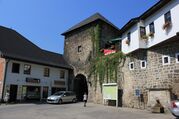
|
|
| المدينة المسورة بوتشيتلي | كانتونا الهرسك-نيريتفا | نعم | جيدة | 
|
|
| المدينة المسورة فيدوشكي | ستولاك | نعم | محفوظة | ||
| المدينة المسورة فراتنيك | كانتونا سراييفو | نعم | جيدة | 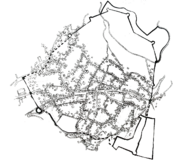
|
فراتنيك هي واحدة من أقدم أحياء سراييفو. |
بلغاريا
- هيساريا – المدينة الرومانية القديمة لا تزال محاطة تقريبًا بالكامل ببقايا جدرانها الدفاعية المحفوظة جيدًا.
- نيسيبار – مدينة جزيرة محصنة
- نيكوبوليس أد إستروم – مدينة رومانية، نيكيوپ، ڤليكو ترنوفو
- نيكوبوليس أد نيستوم – مدينة رومانية، جارمين، غوتسي ديلتشيف، مقاطعة بلاگوڤگراد
- پليسكا – كأول عاصمة بلغاريا الدانوبية
- بلوفديف – التحصينات والجدران – البوابة الشرقية لفيلبوپوليس، هيسار كابيا ونيبيت تيپه
- ڤليكو ترنوفو – ثلاث تلال محصنة – حصن ترابيزيتسا، حصن تسارڤيتسا و"سڤيتا گورا" تشكل مدينة عاصمة بلغاريا
كرواتيا
| المكان | المقاطعة | متاح الوصول | الحالة | الصورة | ملاحظات |
|---|---|---|---|---|---|
| بويي | 
|
||||
| دوبروفنيك | مقاطعة دوبروفنيك-نيريتفا | نعم | جيدة | 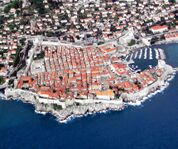
|
دوبروفنيك تتمتع بتحصينات مدينة محفوظة جيدًا تشمل أبراجًا وبوابة ومسارًا على السور وحصنين يحميان الأرصفة. أسوار دوبروفنيك من بين الأفضل والأكثر تكاملًا في أوروبا. |
| قصر دقلديانوس | سبليت | نعم | جيدة | 
|
لا يزال جزء كبير من أسوار قصر دقلديانوس قائمًا حتى اليوم، بما في ذلك ثلاث بوابات وأجزاء طويلة من الجدران الدفاعية الرومانية المحصنة. تم تدمير معظم الأبراج، باستثناء ثلاث أبراج مربعة، كل منها يقع في زاوية من القصر. شمال مركز المدينة توجد بقايا تحصينات، تشمل أجزاء من الجدران وحصنًا يقع في حديقة. |
| غروجنجيان | 
|
||||
| هفار | نعم | جيدة | 
|
||
| كورشولا | نعم | جيدة | 
|
بوابة المدينة | |
| كرك | نعم | 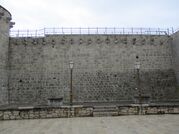
|
أسوار مدينة كرك اكتسبت شكلها الحالي بين القرنين 12 و15، ولكن المدينة نفسها كانت محصنة منذ العصر الروماني. | ||
| كارلوفاتش | 
|
أسوار مدينة كارلوفاتش، بُنيت عام 1579 على شكل نجمة بست نقاط مع حصون. | |||
| أوميشال | |||||
| أوبرتالي | 
|
||||
| موتوفون | نعم | جيدة | 
|
||
| نين | نعم | 
|
|||
| نوفيغراد | 
|
||||
| نوفيغراد | 
|
||||
| باغ | 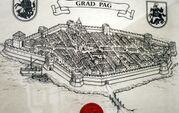
|
||||
| بوريك | نعم | 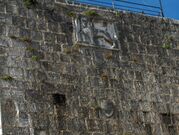
|
|||
| بريموشتين | 
|
||||
| روتش | 
|
||||
| روفينج | نعم | 
|
|||
| سيني | 
|
بوابة المدينة | |||
| أسوار ستون | نعم | جيدة | 
|
الجدران المحصنة بين مالي ستون وستون بُنيت في القرنين 14 و15، عند البرزخ في شبه جزيرة بيليساك، شمال دوبروفنيك؛ جدار مدينة بطول 890 مترًا و"السور العظيم" بطول 5 كيلومترات خارج بلدة ستون. | |
| شيبيينيك | نعم | 
|
|||
| تروغير | نعم | جيدة | 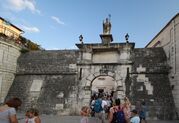
|
بوابة المدينة | |
| زادار | نعم | جيدة | 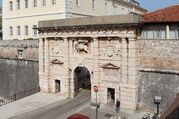
|
تحتفظ زادار بحوالي نصف جدارها. |
قبرص
| المكان | الحالة | الصورة | ملاحظات |
|---|---|---|---|
| فاماغوستا | سليمة | 
|
كانت أول تحصينات رئيسية في فاماغوستا هي برج أوثيلو، الذي بناه اللوزينيانيون في القرن الرابع عشر وتم تعديله لاحقًا من قبل الفينيسيين. كما بنى الفينيسيون جدران المدينة في القرنين الخامس عشر والسادس عشر، ولا تزال هذه الجدران سليمة حتى اليوم. |
| نيقوسيا | سليمة | 
|
تم بناء أولى التحصينات في نيقوسيا في القرنين الثالث عشر والرابع عشر. قام الفينيسيون بهدم التحصينات القديمة واستبدلوها بتحصينات دائرية مزودة بأبراج في أواخر ستينيات القرن السادس عشر. لا تزال الجدران سليمة إلى حد كبير باستثناء بعض الاختراقات. |
| كيرينيا | البقايا تشمل أجزاء من الجدران، ثلاثة أبراج، وبوابة المدينة. القلعة سليمة. | كانت أول تحصينات رئيسية في كيرينيا هي قلعة كيرينيا، التي بنيت في العصر البيزنطي. قام اللوزينيانيون في القرن الرابع عشر بتعديل القلعة وبناء جدران المدينة. تم هدم معظم الجدران في عام 1570 بعد استسلام المدينة للأتراك عقب سقوط نيقوسيا. ولأن فاماغوستا كانت لا تزال تقاوم، هدم الأتراك معظم الجدران خوفًا من تمرد أو هجوم من قبل الفينيسيين والأسطول المسيحي الكبير. أبقوا فقط على أبراج الجدران لتعزيز التغطية والدفاع عن القلعة. |
جمهورية التشيك
- بخينيه
- بيلا بود بزدجيزم
- بيناكي ناد يزرو
- بيرون
- بوخوف
- بور
- برنو
- برووموف
- برونتال
- تشاسلاف
- تشيكسا ليبا
- تشيكيه بوديوفيتسه
- تشيكي برود
- تشيكي دوب
- تشيكي كروملوف
- خيـب
- خروديم
- خيشيه
- داتشيه
- دوماجليتسه
- دفور كرالوفي ناد لابم
- فريدلانت
- فولنك
- هافليتشكوف برود
- هلوتشين
- هوراجدوفيتسه
- هورشوفيسكي تين
- هوستينه
- هرادتس كرالوفي
- هرانيتسه
- يابلووني في بودييشتيجي
- يارومير
- يفيتشكو
- يتشين
- يهلـافا – تبقى أجزاء كبيرة من أسوار المدينة إلى الجنوب، الغرب، والشرق من المدينة القديمة. توجد أجزاء صغيرة متبقية على الجانب الشمالي. كما تُعد التحصينات مثالًا جيدًا على زفينجر.
- يندريخوف هرادتس
- يوسيفوف
- كاداني
- كلاتوفي
- كولين
- كوستيليتس ناد لابم
- كوريجيم
- كرنوڤ
- كتنا هورا
- كرومييريج
- لانشكراون
- ليبنيك ناد بيتشفو
- ليتوميشل
- ليتوفل
- لوكت
- لوني
- ميلنيك
- ملادا بوليسلاف
- موهلنيتسه
- ناخود
- نوفي ميستو ناد متوجي
- نوفي بيدجوف
- نوفي يتشين
- نيمبورك
- أودري
- أولوموتس
- أوبوتشنو
- أوبافا
- أوسوبلاها
- أوسترافا
- أوستروف
- باردوبتسه
- بيسك
- بلانا
- بلزن
- بلوملوف
- بوليشكا – تبقى ما يقرب من 80% من أسوار المدينة في حالة ممتازة.
- براخاتيتسه
- براغ
- بريلووتش
- بريروف
- بروستيوف
- رابتشتيين ناد ستريلو
- راكوڤنيك
- راتايي ناد سازافو
- روكيتساني
- رژميتال بود ترشينيم
- سلاني
- سوبسلاف
- سوبوتكا
- ستارا بوليسلاف
- شتيرنبرك
- شترامبرك
- سترازنيس
- ستريبرو
- سفيتافي
- شومبرك
- سوشيتسه
- تابور
- تاخوف
- تيبلا
- توفاتشوف
- تريبون
- ترونوف
- توجيم
- أوهرسكي برود
- يونيشوف
- اوستي ناد اورليتسي
- فالتيس
- فيلفاري
- فيدنافا
- فودنياني
- فراني
- ڤيسوكي مييتو
- زابرجيه
- زاكوبي
- جاتيتسه
- جلوتيتسه
- زنويمو – أكثر من نصف الأسوار محفوظة، مع بقاء أجزاء كبيرة من زفينجر.
الدنمارك
- فريدريشا، حصون عصر النهضة الواسعة إلى الشمال والغرب من المدينة، وحصون مواجهة للبحر.
- كوبنهاجن، حصون عصر النهضة الواسعة إلى الجنوب والشرق، مع بقايا آثار إلى الشمال والغرب، وقلعة جميلة عند مدخل الميناء، بالإضافة إلى ثلاث جزر حصينة صغيرة خارج مدخل الميناء.
- نيبورغ – تشمل البقايا ثلاث حصون محفوظة وبوابة للمدينة، ولا تزال البلدة القديمة محاطة إلى حد كبير بخندق مائي يشير إلى مواقع الحصون الأخرى التي تم هدمها الآن.
- ستيجه، لا تزال إحدى بوابات المدينة، "مولبورتن"، موجودة. كما تبقى معظم السور الترابي والخندق الجاف المحيط بمركز المدينة.
إستونيا

- بارنو، تبقى سور مع حصنين، خندق مائي وبوابة مدينة إلى الغرب من البلدة القديمة. تم تحويلها الآن إلى متنزه، "متنزه ڤالي".
- تالين (وتومبيا)، انظر أسوار مدينة تالين، معظم الأسوار والأبراج لا تزال قائمة.
- تارتو، تبقى أجزاء قليلة جدًا.
- نارڤا، انظر حصون نارڤا، تشمل تسعة حصون والقلعة، مع استعادة كاملة لكل من قلعة هيرمان وحصن فيكتوريا.
فنلندا
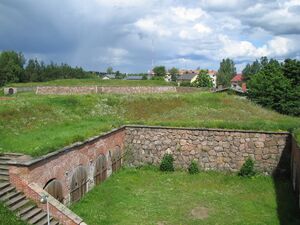
- هامينا محاطة بتحصينات جدارية على شكل نجمة بطول حوالي 4–5 كم.
- لابينرنتا يقع مركز البلدة القديم داخل حصن.
- لوفيزا كان من المخطط بناء حصن كامل حول البلدة، ولكن تم استكمال حصنين فقط.
- سوومنلينا حصن بحري مأهول قبالة ساحل هلسنكي.
فرنسا
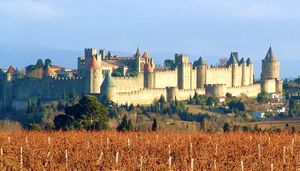
- أكينجي
- آغد
- آيغ مورت
- إيني لو شاتو
- إير سور لا ليس
- إيكس أون بروفانس
- ألنصون، أورن
- أمانس، أوت سون
- أمبواز، أندر إيه لوار
- أمشوير
- أنجيه، ماين ولوار
- أنغوليم
- أنتيب
- أبت
- أردر
- آرل
- آراس
- أوبيني سور نير
- أوش
- أوتون
- أوفيه إيه لا شابلوت
- أفالون
- أفان سور هيلب
- أفينيون
- أفرانش
- إيهير
- باغي لو شاتيل
- بارجيم
- بو دو بروفانس
- باڤي
- بايون
- بازاس
- بوغانسي
- بون
- بوفيه
- بيگيوس
- بليم
- بيرغيم، هوت رين
- بيرغ
- بيسانسون
- بلوا، لوار وشير
- بويرش
- بوسيرون
- بونفال، أير ولوار
- بوغ
- بوربون لانس
- بورج
- بور لو روا
- بريانصون
- بريون
- بريو
- بروش، لوط وغارون
- كاديلاك، جيروند
- كان
- كاهور
- كامبل
- كابديناك
- كاركاسون
- كاريغنان، أردين
- كودبيك أون كو
- سيرنيه، هوت رين
- شالون سور سون
- شامديو
- شامبينيول
- شامبليت
- شارلويل ميزيير
- شاتو تييري، أين
- شاتليه
- شاتيون سور سون
- شيرو
- كليرمون فيران
- كلوني
- كولونج لا روج
- كولمار
- كولمارس
- كومبيين
- كمبرييناك
- كونكارنو
- كوندي سور ليسكو
- كوربيني
- كور سور سييل
- كورميري
- كوسن كور سور لوار
- كوكي لو شاتو أوفريك – أجزاء كبيرة من الجدران باقية، رغم أنها في حالة متهدمة جزئيًا. تشمل البقايا عدة أبراج وأجزاء من الجدار الساتر وثلاث بوابات، وهي بورت دو لون، وبورت دو سواسون، وبورت دو شوني.
- كورتيزون
- كريسي لا شابيل – بقايا مجزأة
- كريكي
- كوكورون
- كويزو
- كوسيه
- داخشتاين، باس رين
- دامباخ لا ڤيل
- داكس، لاند
- ديزيز
- دي، دروم
- ديميرينغ
- دييب، سين ماريتيم
- دينان
- دول، جور
- دومفرونت، أورن
- دوم، دوردون
- دون سور أورون
- إسباليون
- أو، سين ماريتيم
- إڤرو
- فاليز، كالفادوس
- فوكونيه إيه لا مير
- فيور
- فيجاك
- فوس سور مير
- فوجير
- فريجوس، ڤار
- جيفي
- غرانڤيل، مانش
- غرينوبل
- غيمار، هوت رين
- غيراند
- هنبونت
- هيرلسهايم بريه كولمار
- هيدين
- هيرس بروياج
- أونفلور
- إيل ديه
- إيلفورت
- إيسودن، أندر
- إستريتس
- جيني
- لا كڤاليري
- لا شارتيه سور لوار
- لا شاسانيه
- لا كوفيرتواراد
- لا غروت
- لا مارتير
- لا روش دو گلون
- لا روشيل
- لا روش بوزاي
- لا سافيتا، پوي دو دوم
- لا توربي
- لانجر
- لانيه
- لانتابات
- لون
- لارسيفو أروس سيبيتس
- لارسينجل
- لافال، مايين
- لو كاستيليت، ڤار
- لو كروزيه
- لو مالزيو ڤيل
- لو مون سان ميشيل
- لو پاليه
- لو پوييه لاڤال
- لو كينوا
- لو تور
- ليه أندليه
- ليه كليوس
- لوڤنس
- لوش – أجزاء كبيرة منها لا تزال سليمة. البلدة العليا وقلعة لوكش مبنيتان على تل يوفر موقعًا استراتيجيًا يطل على الريف المحيط ونهر أندر. الجدران الخاصة بالمدينة العليا لا تزال سليمة إلى حد كبير وتشمل بقايا بورت دو سانت أورس، وبورت رويال المحفوظة جيدًا، وأجزاء طويلة من الجدران الساترة والعديد من الأبراج والحصون. أما جدران البلدة السفلى فقد تم تدميرها جزئيًا، ولكن 4 أبراج، وعدد قليل من الأبراج الصغيرة المضافة لاحقًا، وقسم طويل من الجدران الساترة، وبوابتين محفوظتين جيدًا (بورت ديه كوردلييه وبورت بيكوايس التي تُستخدم الآن كدار البلدية) ما زالت سليمة.
- لودون، ڤيين
- لوسيرام
- ميسود
- مان
- ماركولي
- مارسال، موسيل
- مارڤيل، ميوز
- موبوج
- مند، لوزير
- مينيتو سور شير
- ميتز
- مورساك
- مولسهايم
- مونسي سور دوردون
- مون دوبلو
- مونپازير
- مونتارشر
- مونتبريزون، لوار
- مون دو مارسان
- مونتيو
- مونفور سور مو
- مونتڤيليه
- مونت لويس
- مونتريال، يون
- مونتروي، با دو كاليه
- مونتروي بيلاي
- مونتڤردن
- موريه سور لوين
- مورليكس
- موگين
- موزون، أردين
- ناباس، بيرينيه الأطلسية
- ناج إيه سولورج
- نانت
- ناربون
- نڤارينكس
- نيو بويس
- نو بريساك
- نيفر
- نيس، ألب ماريتيم
- نيول سور لو أتيس
- نيم
- نوتر دام دي غراڤنشون
- أوبرهسلاش
- أوبيرناي
- أورادور سور غلان، هوت ڤين
- أورانج، فوكلوز
- أورگون
- أوستابات أسمي
- باريس
- بارثيناي
- پيروج
- پرتويس
- پسم
- پلاسي
- بلورميل
- پوitiers، ڤيين
- پولين، جور
- پومييه، لوار
- بونت دي لارش
- بونتجيبوه
- بونت لآبي دأرنو
- بونتواز
- پويي لي فو
- پراد لو ليز
- پرات دي مول لو بريست
- پروڤين
- بويكسيلسي
- كامپير، فينيستر
- كانت
- ران
- روزان
- لا ريه أول
- ريفست ديه بروسيه
- ريبوفيل
- ريشيليو، أندر إيه لوار
- ريون
- ريكيڤير
- روكامادور
- روشفور، شارنت ماريتيم
- روكروي
- رودماك
- روميني
- روسايم
- روفاخ
- روي، سوم
- رومس
- سانت برتران دي كومينج
- سانت ديو سور لوار
- سانت كروا سور بوشي
- سانت إميليون، جيروند
- سانت، شارنت ماريتيم
- سانت أولاليه ديه سيرنون
- سانت سوزان إيه شاميه
- سانت إتيان ديه بايغوري
- سانت فيليكس لوراغيس
- سانت جينسي
- سانت هيپوليت، هوت رين
- سانت جان بيه دو بورت
- سانت جونيان – لا تزال هناك بقايا برج وجدار ساتر خلف المنازل عند تقاطع بوليڤارد ديه ريپوبليك ورو دي بريش.
- سانت لوران ديه أربر
- سانت ليجيه ماجنازايكس
- سانت لو
- سانت ماكاير
- سانت ماركوف، مانش
- سانت مارتين داروسا
- سانت ميتر لي ريمپارت
- سانت أومير
- سانت پاستور
- سانت پول دي ڤانس
- سانت بومبون
- سانت سولياك
- سانت سولپيس ديه فافير
- سانت تريڤير سور موينان
- سانت ڤالري سور سوم – لا تزال هناك أجزاء كبيرة باقية، بما في ذلك بورت دو نڤير، وبورت جان دارك، وأجزاء من الجدران الساترة وبعض الأبراج. يظهر تلة تدعى كاب هورنو فوق المدينة، وهي الموقع الأكثر احتمالًا للحصن والميناء الروماني على الساحل السكسوني المعروف بـ "لوكوس كوارطينسيس سيفي هورنينسيس".
- سانت ڤيرين
- سايساك
- سارالب
- ساربوغ
- سامور، ماين ولوار
- سوفيان
- سيليستات
- سيمور إن أوكسوا
- سينليس، واز
- سان، يون
- سيبتيم
- سيستيرون
- سواسون
- سوريل موسيل
- ستراسبورغ
- سوڤر
- تان، هوت رين
- ثيونڤيل، موسيل
- ثوار
- تيلاك
- تينكري
- تول، مورث إيه موسيل
- تولوز
- تور، أندر إيه لوار
- ترو
- توركهايم
- أوزيس
- ڤابري
- ڤان
- ڤوكولور، ميوز
- ڤيناسك
- ڤانس
- ڤيردان، ميوز
- ڤيرڤين
- ڤيزليه
- ڤيان
- ڤيين، إيزير
- ڤيينس، فوكلوز
- ڤييڤي لو ريي
- ڤيلفرانش دو كونفلان
- ڤيلنوف سور يون
- ڤيتر، إيل إيه ڤيلين
- ڤوفان
- وانغن، باس رين
- واتڤيلير
- وستهوفن
- ڤيسمبورغ
- زيلنبيرغ
ألمانيا


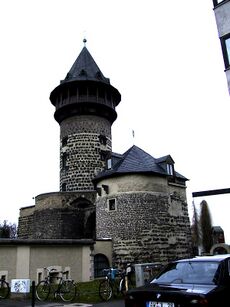





- آخن، لا تزال بعض أجزاء الجدران الداخلية قائمة على طول تمبلغرابن (عند الزاوية مع شارع آيلفشورنشتاين وزاوية شارع بونت). من الجدران الخارجية لا تزال ثلاثة أبراج قائمة حتى اليوم، وهي لانجر تورم، بفافنتورم وماريينتورم. تبقى بوابتان فقط للمدينة، بونتتور ومارشيرتور، وهما من أفضل البوابات المحفوظة في ألمانيا.
- آخ
- آبنسبرغ
- آرويلر
- آيخاخ
- ألتنتريبوتو – تشمل البقايا بعض أجزاء من السور، برج وبوابتين للمدينة، براندنبورغر تور وديمينر تور.
- أنابيرغ-بوخولتز
- أمبرغ
- آمونيبورغ
- أنديرناخ
- آربيرغ – تبقى فقط بوابة واحدة للمدينة.
- آرنتشتات
- آشافنبورغ
- أوب – أجزاء كبيرة من الأسوار لا تزال قائمة، بما في ذلك بعض الأبراج. لا تزال بوابة واحدة للمدينة، وهي زنتتورم.
- بابنهاوزن
- باد كولبرغ-هيلدبورغ
- باد فرانكنهاوزن
- باد هيرسفيلد
- باد لانغنسالزا – أجزاء كبيرة من الأسوار لا تزال قائمة، بما في ذلك 12 برجًا جداريًا وبوابة مدينة واحدة، كلاجتور.
- باد مونسترآيفل
- باد نويشتات أن دير زاله
- باد أورب
- باد روداخ
- باد سودن-أليندورف
- باد فالدسي
- باد فيمفن
- باخراخ
- بالنشتيدت
- باربي
- بوتسن
- بايلنغريس
- برشينغ
- برلين كانت محاطة بجدار دفاعي منذ حوالي عام 1250 وحتى منتصف القرن السابع عشر، وجدار جمركي من منتصف القرن الثامن عشر وحتى منتصف القرن التاسع عشر. الجدار المعروف باسم جدار برلين الذي كان موجودًا بين عامي 1961 و1989 ادعت سلطات ألمانيا الشرقية أنه دفاعي، لكنه كان في الواقع لمنع الهجرة غير المصرح بها. لا تزال أجزاء من الجدار الذي يعود للقرون الوسطى في برلين قائمة على طول شارع ليتنشتراسه.
- برناو باي برلين
- برنكاستل – لا تزال بوابة مدينة واحدة، وهي غراخر تور.
- بيزيغهايم
- بلانكنبورغ (هارتز)
- بودينفيردر
- بويزنبورغ
- بوبارد
- بوننيغهايم – تبقى بعض أجزاء الجدران وبوابة مدينة.
- براندنبورغ
- بوخن
- بورغاو
- بورغ باي ماغديبورغ
- بورغهاوزن
- بوتسباخ
- بودينغن
- كالبه
- كيمنتس – لم يبق سوى برج واحد، وهو روتير تورم (البرج الأحمر).
- كوبورغ
- كولونيا
- كرايلسهايم – توجد بعض البقايا شمال رينغغاسه، بما في ذلك برج جداري. لا يزال برج آخر على طول شارع غرابنشتراسه.
- دارمشتات
- داوزناو – الأسوار لا تزال تقريبًا سليمة. تبقى بوابة واحدة، وهي تور تورم.
- ديليتش
- ديمين أجزاء كبيرة من أسوار المدينة لا تزال قائمة على طول نوردماور، باوفشتراسه وزودماور. لا تزال بوابة مدينة واحدة، وهي لويسنتور.
- ديتلباخ
- ديلنبورغ
- ديلينغن على الدانوب
- ديلسبيرغ
- دينكلسبول – الأسوار التي تعود للقرون الوسطى لا تزال سليمة بالكامل، بما في ذلك 4 بوابات و19 برجًا.
- دولنشتاين
- دوميتز
- دوناوورث
- درسدن – كانت أسوار درسدن الدفاعية من أوائل الأسوار في ألمانيا، مستوحاة من النموذج الإيطالي الأسبق. أحاطت الأسوار بـ "المدينة القديمة" جنوب نهر إلبه، و"المدينة الجديدة" شماله. تمت إزالة الأسوار، البوابات والخنادق إلى حد كبير حوالي عام 1815 بعد الحروب النابليونية، باعتبارها قديمة الطراز للحروب الحديثة. تم اكتشاف بعض الأجزاء الصغيرة وإقامتها كمتحف فستونغ درسدن https://web.archive.org/web/20160509160153/http://www.festung-dresden.de/de/festung_dresden/museum/ أسفل شرفة برول الأكثر شهرة.
- دوديرشتات
- دويزبورغ
- إبيرن
- إيبرباخ (بادن)
- إيبيلشتات
- آيشتات
- آينبك
- آيزنهايم
- إلوغانغن
- إلتفيل أم راين
- إمدن
- إيردينغ
- إرلانغن – لا تزال بعض أجزاء الجدران على طول نوردليش شتاتماورشتراسه، فوهرشتراسه وشولشتراسه.
- فويشتوانغن
- فلادنغن
- فورشهايم
- فرايبيرغ
- فرايبورغ، ألمانيا
- فريشتات
- فريدبرغ، باڤاريا
- فرينسهايم
- فريكنهاوزن أم ماين
- فريتسلار
- غانغلت
- غارديليغن – توجد عدة بقايا من السور القديم، بما في ذلك بوابة سالتسفيدلير تور، بقايا بوابة شتندالر تور وبعض أجزاء السور.
- غارتس (أودر) – تشمل بقايا الأسوار حول المدينة على بعض الأجزاء الكبيرة، الأبراج وبوابة مدينة واحدة، شتيتينر تور.
- غايسا
- غيلنهاوزن
- غيرمرسهايم
- غيرولشوفن
- غولهايم – لا تزال بوابتان للمدينة، كيرتسنهايمر تور ودريزينر تور. لا يزال برج واحد، أولريخستورم.
- غريفنبرغ – تشمل البقايا ثلاث بوابات محفوظة جيدًا، إغلوفشتاينر تور، هيلتبولتشتاينر تور وجيشتايغر تور. لا تزال بعض أجزاء الجدران بالقرب من جيشتايغر تور وخلف المنازل على طول آم جيشتايغر وشولغاسه.
- غريبنشتاين – لا تزال معظم أسوار القرون الوسطى تحيط بالمدينة القديمة. تبقى بوابة واحدة، وهي بورغتور.
- غريدينغ
- غريما
- غريمن لا يزال برج واحد، واسرتورم. لا تزال البوابات الثلاثة الأصلية للمدينة، شترالسوندير تور، غرايفسفالدر تور ومولينتور.
- غروس أوستهايم
- غوندلفينغن أم الدانوب
- غوندلسهايم
- غونتسنهوزن
- غوسترو – لا تزال بعض أجزاء الجدران جنوب الكاتدرائية وعلى طول جيلفينر ماور.
- هالدنسلبن
- هانوفرش موندن
- هاتينغن
- هايدلشهايم – لا تزال بوابة مدينة وبرج جداري.
- هايدينغسفيلد، جزء اليوم من فورتسبورغ
- هايلباد هايلغنشتات
- هيربورن
- هرييدن
- هيلدبورغهاوزن
- هيرشهورن
- هاردغسن
- هاميلبورغ
- هولفيلد – تشمل البقايا بوابة مدينة واحدة، أوبيره تور، وبعض أجزاء الجدران جنوب المدينة القديمة.
- هامبورغ، ألمانيا
- هاملن
- هاملبورغ
- هوكشتات أن دير دوناو
- هورب أم نيكار – لا تزال أجزاء كبيرة من الأسوار.
- إنغولشتات
- إبنهوفن
- ينا
- ليبتسيغ تشمل البقايا موريتسباستاي.
- فورتسبورغ
- ڤايسنفيلس
- ڤيزنبورغ.
- كاومنهايم
- كايزرسلاوترن
- كيندل بروك
- كورنباخ
- كروناش
- كولمباخ
- كوبينهايم
- كاوفبويغن
- لاوزيتس
- لاندسبرغ أم ليخ
- لاندشوت
- لانغنزن
- لاوخة أن دير أونشتروت
- لاوخهايم
- لاوبنغن
- لاوف أن دير بيغنتز
- لاوفين
- لاوفين أم نيكار – يتكون الجزء القديم من المدينة من ثلاثة أجزاء. بينما تنقسم البلدة بالنهر نيكار، تقع القلعة على جزيرة صغيرة محاطة بالنهر. على الضفة اليسرى يوجد جزء كبير من الجدار بجانب الكنيسة. على الضفة اليمنى، لا تزال بعض الأبراج وأجزاء من الجدار.
- لايبهايم
- لوهر أم ماين
- ماينتس – تشمل البقايا قلعة مربعة الشكل محفوظة جيدًا، البرج القديم الإسكندر.
- ميمنغن
- مونشنبرغ
- مونشن لا تزال بعض بوابات المدينة القديمة، بالإضافة إلى أجزاء من الجدار الدفاعي المتأخر.
- ميونيخ – توجد بقايا تشمل بوابة رومانية.
- ميونبرغ
- نورنبرغ
- نيورمبرغ
- نويبراندنبورغ
- نيدرنبرغ لا تزال أجزاء من الجدران بالإضافة إلى برج واحد.
- نيورت – معظم أسوار البلدة لا تزال سليمة.
- أوبرنبرغ أم ماين
- فولفسبورغ
- ڤيرتشايغ
- ڤيرتبيرغ
- ڤينزنهاوزن
- ڤولفغانغن – تشمل البقايا ثلاثة أبراج وبعض أجزاء الجدران وبوابة.
- زيورن
- زوندربرغ
- زولبش
- زفايكاو.
جبل طارق
اليونان
لا تزال العديد من المدن والبلدات تحتفظ بجزء من أسوارها الدفاعية، بما في ذلك:
- أرتا
- أثينا – هدمت معظم الأسوار، انظر أسوار مدينة أثينا.
- خانيا – انظر تحصينات خانيا.
- خيوس
- كورفو (مدينة)
- دراما – أجزاء كبيرة من أسوار المدينة لا تزال قائمة في الجهة الشمالية والشرقية من البلدة القديمة، بما في ذلك برجين وأقسام من الجدار.
- هيراكليون كانديا الخندق – انظر تحصينات هيراكليون وحصار كانديا – لا تزال أسوار العرب والبيزنطيين موجودة بنسبة حوالي 20%، وأسوار الفينيسيين التي يبلغ طولها 7.5 كم لا تزال محفوظة بنسبة 95%. يعيش حوالي 30,000 شخص الآن داخل الأسوار الفينيسية. بوابتان وقلعة واحدة في البحر (كوليس).
- يوانينا – انظر قلعة يوانينا.
- كاستوريا – بقايا متفرقة.
- كافالا (جزء كبير من الأسوار البحرية لا يزال قائماً).
- كيساموس
- كوموتيني
- كوروني – التحصينات المحفوظة للقلعة والمدينة العليا.
- ميسولونغي
- مونيمفاسيا
- ميستراس
- نافبليون
- نافباكتوس
- بريفيزا
- ريثيمنو – انظر حصن ريثيمنو.
- رودس – انظر تحصينات رودس.
- سالونيك – انظر أسوار سالونيك.
- فيريا (يبلغ طول الأجزاء المتبقية من الأسوار البيزنطية حوالي 170 مترًا).
هنغاريا
- بودا– تل القلعة محاط بتحصينات من العصور الوسطى والعصور الحديثة المبكرة محفوظة جيداً. لم يتبق سوى قسم قصير من أسوار حي فيزيفاروش.
- بيست– أجزاء من أسوار المدينة التي تعود إلى القرن الخامس عشر محفوظة داخل ساحات المنازل التي بنيت لاحقاً.
- إيغير– بعض الأجزاء محفوظة، لكن معظم الأسوار تم هدمها.
- جيور– تم هدم الأسوار في القرن التاسع عشر ولكن بعض الأجزاء لا تزال محفوظة.
- كوماروم
- كيشزغ
- موشونمجياروفار– تم هدم الأسوار في عشرينيات القرن التاسع عشر.
- بيتش– أجزاء طويلة من الأسوار التي تعود إلى العصور الوسطى محفوظة وتم تحريرها من التدخلات اللاحقة.
- شاروشباتاك
- شوبرون– دائرة الأسوار التي تعود إلى العصور الوسطى بنيت جزئياً على أسس رومانية قديمة.
- سيشيني– بعض أجزاء أسوار المدينة لا تزال محفوظة.
- سيكشفهيرفار– أجزاء طويلة من الأسوار التي تعود إلى العصور الوسطى لا تزال محفوظة.
- فاتس– بعض الأجزاء وبرج واحد محفوظة.
- فيزبرم– البلدة القديمة المسورة تقع على تل القلعة.
جمهورية أيرلندا
| المكان | المقاطعة | الحالة | الصورة | ملاحظات |
|---|---|---|---|---|
| آردي | مقاطعة لاوث | |||
| أثينري | مقاطعة غالواي | 
|
||
| أثلون | مقاطعة ويستميث | |||
| باندون | مقاطعة كورك | |||
| كارلينغفورد | مقاطعة لاوث | 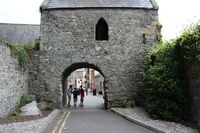
|
||
| كاشيل | مقاطعة تيبيراري | |||
| كلونميل | مقاطعة تيبيراري | 
|
||
| كورك | مقاطعة كورك | |||
| دروغيدا | مقاطعة لاوث | 
|
بوابة القديس لورنس في دروغيدا هي باربيكان أصلي يعود للقرن الثالث عشر. بوابة أخرى تُعرف بـ "بوابة الزبدة" موجودة في المدينة، ويُعتقد أنها كانت تستخدم كمدخل للمشاة نظرًا لعدم وجود طريق متصل بها. | |
| فيثارد | مقاطعة تيبيراري | 
|
لا تزال تحتفظ بأكثر من كيلومتر من الأسوار التي تعود للعصور الوسطى – 90% من المحيط. بعض الأجزاء تصل إلى ارتفاع أكثر من 8 meters (26 feet). | |
| دبلن | مقاطعة دبلن | 
|
||
| غالواي | مقاطعة غالواي | 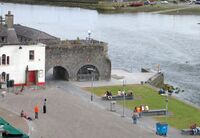
|
||
| كيلكيني | مقاطعة كيلكيني | 
|
||
| كيلمالوك | 
|
|||
| ليمريك | مقاطعة ليمريك | |||
| نيو روس | مقاطعة وكسفورد | |||
| رندون / ليكارو | مقاطعة روسكومون | أفضل بلدة مهجورة من العصور الوسطى محفوظة في أيرلندا. | ||
| تريم | مقاطعة ميث | |||
| ووترفورد | مقاطعة ووترفورد | 
|
||
| وكسفورد | مقاطعة وكسفورد | 
|
||
| يوغال | مقاطعة كورك | 
|
إيطاليا
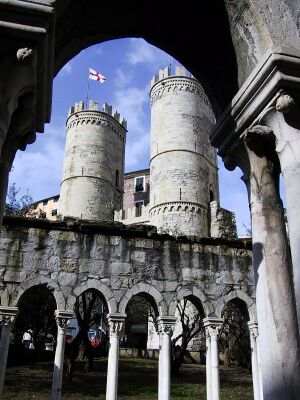

- أكوي تيرمي – ثلاث بوابات للمدينة وبقايا الأسوار.
- أكوتو
- ألبينغا – بقايا متفرقة، بما في ذلك أجزاء من السور و3 بوابات للمدينة.
- ألغيرو
- ألتامورا – بقايا قليلة؛ لا تزال بوابتان مرئيتين، هما بوابة باري وبوابة الشهداء.
- أنكونا
- أنغياري
- أوستا – أسوار رومانية محفوظة تقريبًا بالكامل.
- أبينانو
- أكواسبارتا
- أرتشيفيا
- أسولو
- أسيزي
- أريتزو – أجزاء كبيرة من أسوار المدينة لا تزال موجودة، بما في ذلك عدة أجزاء من السور، 6 باستيونات، 4 بوابات للمدينة، وقلعة محصنة محفوظة جيدًا "فورتسا ميديكا".
- بانيكافالو – بوابتان للمدينة لا تزالان قائمتين.
- باري – تاريخيًا كانت مدينة ساحلية مسورة، لكن لم يتبق سوى بقايا قليلة تشمل باستيونين وقسم قصير من الجدار البحري.
- باسانو ديل غرابا
- باستيا أمبرا
- بيلفيديري أوسترينسي
- بيلونو
- بيرغامو – تحيط بالتلة القديمة للمدينة.
- بيشليه
- بولونيا
- بوسكو مارينغو – جزء كبير من الأسوار الشمالية الغربية مع الأبراج محفوظ.
- بوزولو
- بريشيا – التل المحيط بالقلعة ("تل سيدنيو") محاط بتحصينات من العصور الوسطى والنهضة. أجزاء من الجدران الرومانية والفينيسية لا تزال قائمة جزئيًا.
- بريسانوني – البوابة الغربية لا تزال قائمة وكذلك الجانب الشمالي حيث تُستخدم المنازل كجدران.
- برينديسي – أجزاء عديدة من الأسوار محفوظة، بما في ذلك 5 باستيونات وبوابتان للمدينة: بوابة ليتشي وبوابة ميساني.
- برونيكو – ثلاث بوابات لا تزال قائمة: الغربية، الشمالية، والشرقية.
- بوسيتو
- كالي
- كالياري
- كالتيجيروني
- كاميرينو
- كابوا
- كاستيل بولونيز – ثلاثة أبراج جدرانية لا تزال قائمة.
- كاستيل ديل مونتي
- كاستيل غوفريدو – جزء صغير جدًا من الأسوار وبرج لا يزالان موجودين.
- كاستلفرانكو فينيتو – المدينة القديمة محاطة بالكامل بأسوار من العصور الوسطى وخندق.
- كاستيلساردو
- كاستيغليون ديل لاغو – المدينة القديمة محاطة بالكامل بأسوار محفوظة جيدًا.
- تشيزينا
- سينغولي
- تشيتاديلا – واحدة من أفضل المدن المسورة المحفوظة في إيطاليا.
- كورتونا
- كروتوني
- لوكا – أسوارها محفوظة بالكامل وتحيط بالمدينة القديمة.
- فيرونا – لا تزال أجزاء كبيرة من أسوار المدينة موجودة، بما في ذلك أربعة بوابات للمدينة.
- سيينا – أسوار المدينة محفوظة بشكل كبير.
- سيراكوزا – بقايا جدران من العصور الوسطى.
- روما – تضم أسوار أورليان من الإمبراطورية الرومانية.
- فلورنسا – أقسام محفوظة من الجدران في أجزاء مختلفة من المدينة.
- بولونيا – بقايا من الأسوار التاريخية.
- ميلانو – بقايا من الجدران التي تعود إلى العصور الوسطى وعصر النهضة.
- نابولي – أقسام من الجدران القديمة.
- بريشيا – أسوار النهضة لا تزال قائمة جزئيًا.
- ماروستيكا – الأسوار الدفاعية حول المدينة القديمة محفوظة بالكامل. تشمل 3 بوابات للمدينة، 20 برجًا، وقصرتين، كاستيلو سوبريوري وكاستيلو إنفيريوري.
- مونتيريجيوني – المدينة بالكامل محاطة بأسوار من العصور الوسطى.
- مونتاجنانا – أسوار من العصور الوسطى محفوظة تمامًا وهي من الأكثر إثارة للإعجاب في أوروبا.
- أورفيتو – المدينة القديمة محاطة بالكامل بأسوار صخرية.
- بالمانوفا – مدينة حصينة بنظام "حصن النجمة"، وهي قلعة ذات تسع نقاط.
- بيرودجا – تحتوي على أقسام من الجدران من العصور الرومانية والوسطى.
- تريفيزو – لا تزال أسوار المدينة محفوظة جزئيًا، بالإضافة إلى بوابات المدينة.
- توسكانيا – تحتوي على أقسام محفوظة من الأسوار المحيطة.
- أوديني – بقايا من الجدران وبوابتان لا تزالان قائمة.
- أوربينو – المدينة القديمة محاطة بأسوار محفوظة جيدًا.
- سبوليتو – بقايا من أسوار تعود إلى العصور الوسطى.
- روفيريتو – جزء من الأسوار الحجرية من العصور الوسطى لا يزال موجودًا.
- فولتيرا – المدينة محاطة بأسوار من العصور الوسطى مع أقسام محفوظة جيدًا.
- سان جيميجنانو – المدينة القديمة تحتوي على أبراج وأسوار من العصور الوسطى.
Latvia
- Riga – the best preserved part of the old town walls is the Powder Tower. Just north west of the Powder Tower remains a stretch of wall with a square tower. Foundations of the wall can be seen at Kalēju iela street, and there are fragments of a ruined wall at the site of a demolished building at Minsterejas iela street. The only remains of the earthen ramparts around the old town is a star shaped moat, now transformed into a park.
- Cēsis
- Daugavpils fortress (Not a true walled city, but a huge fortress with buildings)
- Limbaži
- Valmiera
Lithuania
Luxembourg
North Macedonia
Malta
| Place | Region | Condition | Image | Notes |
|---|---|---|---|---|
| Birgu | South Eastern Region | Mostly intact | 
|
An ancient Castrum Maris stood in Birgu since the 13th century. This was rebuilt as Fort St Angelo in the 16th and 17th centuries, when walls surrounding the entire city were built. Most of the fortifications are intact, except for a small part which was destroyed in a magazine explosion in 1806. |
| Cospicua | South Eastern Region | Mostly intact | 
|
The fortifications were built by the Order of Saint John in the 17th and 18th centuries. The city was heavily bombed in the Second World War, but its fortifications remain largely intact although they are in need of restoration. |
| Floriana | South Eastern Region | Mostly intact | 
|
The area was fortified in the 17th century when the Floriana Lines were built. The walls remain largely intact, although in a rather dilapidated state. |
| Mdina | Northern Region | Intact | 
|
The town was first fortified by the Phoenicians, and the current fortifications are based on those built by the Arabs in the 9th to 11th centuries. The fortifications were extensively modified in the Middle Ages, and then by the Order of Saint John until the 18th century. The walls were recently restored, and they are some of the best preserved fortifications in Malta. |
| Senglea | South Eastern Region | Partly intact | 
|
The town was fortified in the 1550s by the Order of Saint John. Most of its fortifications including Fort Saint Michael were dismantled in the 19th and 20th centuries, and the walls sustained damage in World War II. However, some still survive to this day, including the impressive seaward bastions and part of the land front. |
| Valletta | South Eastern Region | Mostly intact | 
|
The fortifications of Valletta were built by the Order of Saint John between 1566 and 1571, and continued to be modified several times in the following centuries. The City Gate was rebuilt five times, the latest one being completed in 2014. The fortifications of Valletta remain intact, except for a lunette that was demolished in the 19th century and some breaches in the walls. |
| Victoria | Gozo Region | Intact (Cittadella) Demolished (city walls) |

|
The area was first fortified in the Bronze Age, and was one of the earliest settlements on the Maltese islands. It became the administrative centre of Gozo during Punic-Roman rule. The city of Rabat (now also known as Victoria) was fortified during the Middle Ages, with the acropolis of the Roman city being converted into a castle known as the Cittadella. The city walls were demolished in the 17th century, and at this point the Cittadella was rebuilt by the Order of Saint John. No remains of the city walls survive, but the Cittadella survives intact. |
Monaco
Montenegro
- Kotor
- Bar
- Budva
- Herceg Novi
- Kotor – built by Illyrian tribes in the 9th century and enlarged many times from the 13th century until the 19th century.
- Podgorica
- Sveti Stefan
- Ulcinj
Netherlands
| Place | Province | Accessible | Condition | Image | Notes |
|---|---|---|---|---|---|
| 's-Hertogenbosch | North Brabant | Yes | Sizable parts of the fortifications remain intact. | 
|
Of the first city wall, built in the 13th century, one tower, belonging to one of the city gates, remains incorporated in a house on the Hinthamerstraat. Another remnant of the first city wall is formed by a gate over one of the arms of the Binnendieze River near the Korte Waterstraat. Sizable sections of the second, 13th-century city walls, and 17th- and 18th-century bastions remain intact as they serve as flood prevention measures. Of special note is the 17th-century pentagonal citadel. |
| Aardenburg | Zeeland | Vestiges of the fortifications are visible in the landscape. | 
|
In 1625 AD, a new trace of earthen ramparts was built. These defenses were demolished between 1688 and 1701 AD. One city gate, the Westpoort, survives. Additionally, remnants of bastions, ravelins, and other outworks are clearly distinguishable in the fields surrounding the town. The foundations of a Roman gatehouse with 2 towers can be found at the Burchtstraat. The foundations of a Roman tower are now incorporated in the playground of a local school. | |
| Amersfoort | Utrecht | Yes | Sizable parts of the fortifications remain intact. | 
|
Of the first 13th-century city wall, one tower and the barbican of one gate, the Kamperbinnenpoort, remain. After the enlargement of the city in 1450 AD, houses were built on the location of the first wall, and occasionally incorporating fragments of that wall in their structure. Of the 15th-century wall, several stretches remain to the north-east of the old town, while the foundations of the wall have been made visible on the south-eastern side. Two 15th-century gates remain as well; the koppelpoort, a combined land and water gate, and the Monnickendam, a water gate. |
| Amsterdam | North Holland | One or more individual structures (Bastions, gates, towers, etc.) remain. | 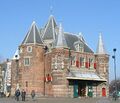
|
Of the medieval walls, the Sint Antoniuspoort is the most important remnant. Other remnants of the same wall are the Schreierstoren and the lower part of one of the towers of the former Regulierspoort. Of the later Baroque defenses, only the Muiderpoort remains intact, while some of the bastions can still be recognizable in the bendy course of the outer moat that still surrounds the old town. The most recent defensive structure around the city is the Stelling van Amsterdam, a 135 km long ring of fortifications around Amsterdam, consisting of 42 forts and other works. | |
| Arnhem | Gelderland | One or more individual structures (Bastions, gates, towers, etc.) remain. | 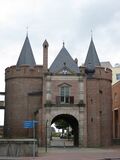
|
Only the 14th-century Sabelspoort remains. | |
| Asperen | Gelderland | One or more individual structures (Bastions, gates, towers, etc.) remain. | 
|
On the side of the Linge River, a stone wall, incorporating the bases of several towers, remains. The water gate, giving access to the old harbor, is partially reconstructed. On the land side, parts of earthen ramparts and moats remain. | |
| Bad Nieuweschans | Groningen | Vestiges of the fortifications are visible in the landscape. | 
|
The walls of the tiny fortified village have been partially demolished, although a small section remains. | |
| Bergen op Zoom | North Brabant | Yes | One or more individual structures (Bastions, gates, towers, etc.) remain. | 
|
Of the medieval fortifications, only the 14th-century Gevangenpoort remains. Of the extensive 17th-century fortifications, only one single ravelin remains. |
| Bolsward | Friesland | Yes | One or more individual structures (Bastions, gates, towers, etc.) remain. | 
|
A moat still encloses the town center. |
| Bourtange | Groningen | Yes | The fortifications were recently reconstructed. | 
|
The original fortifications were demolished in the 19th century, but have been reconstructed from 1960 onwards, in a successful effort to revitalize the village. |
| Breda | North Brabant | One or more individual structures (Bastions, gates, towers, etc.) remain. | 
|
The only notable remnant of the city walls is the Spanjaardsgat gate; a water gate defended by two multiangular towers. It forms part of the defenses around Breda Castle, which in turn formed an integral part of the city walls. | |
| Bredevoort | Gelderland | Yes | One or more individual structures (Bastions, gates, towers, etc.) remain. | 
|
Part of the ramparts, located on the north-east of the town, have been reshaped into a park. To the south-west, a windmill stands on top of a remnant of one of the bastions. |
| Brielle | South Holland | Yes | The city wall remains intact. | 
|
The old town is completely enclosed by earth ramparts, featuring nine bastions, as well as multiple outer works. |
| Brouwershaven | Zeeland | Yes | One or more individual structures (Bastions, gates, towers, etc.) remain. | 
|
Part of the ramparts, located on the east and north of the town, remain intact. |
| Buren | Gelderland | Yes | Sizable parts of the fortifications remain intact. | 
|
On the east side of town, facing the river, an impressive wall remains. On the north-west side of the town, a city gate remains, flanked by a row of houses built against the old town wall. |
| Culemborg | Gelderland | One or more individual structures (Bastions, gates, towers, etc.) remain. | 
|
The old town, its medieval extensions, and the site of the old castle, are still surrounded by a moat. Of the oldest, the 14th-century city wall, one city gate remains, while several fragments of the city wall stand on the south and east sides of the old town. | |
| Delft | South Holland | One or more individual structures (Bastions, gates, towers, etc.) remain. | 
|
The old town is for the most part still surrounded by a moat. Along this moat stand two towers belonging to the medieval wall. On the eastern end of the old town stands the Oostpoort, a 15th-century combined land and water gate. | |
| Doesburg | Gelderland | Yes | Sizable parts of the fortifications remain intact. | The fortifications around the old city have been demolished, but the advanced line of defenses to the east of the city remains intact as part of a nature reserve. | |
| Dokkum | Friesland | Yes | The city wall remains intact. | 
|
The old city is completely enclosed by a line of earth ramparts, featuring five bastions. |
| Dordrecht | South Holland | One or more individual structures (Bastions, gates, towers, etc.) remain. | 
|
The old city is completely enclosed by a moat, while the old harbor is guarded by the Groothoofdspoort, a late medieval city gate, later rebuilt in a Renaissance style. | |
| Elburg | Gelderland | Yes | Sizable parts of the fortifications remain intact. | 
|
The old city is completely enclosed by a moat and a 16th-century rectangular earthen rampart with a bastion at each corner. The rampart was changed into a park in the 19th century, but the defenses are still easily recognizable. Several of the old gates were defended by a barbican, the lower parts of which have been excavated and the casemates of one of the barbicans can be visited. Several sections of the medieval city wall still stand behind the 16th-century rampart. One tower of the medieval wall had been changed into a gate in the 16th century. This structure forms the last remaining city gate of the old town. |
| Enkhuizen | North Holland | Yes | Sizable parts of the fortifications remain intact. | 
|
The landward side of the old town is still completely surrounded by an earthen rampart with five bastions. The last remaining gate facing the landward side of the city is the 17th-century Koepoort. The most impressive remnant of the fortifications is the 16th-century 'Drommedaris' gate, which stands near the harbor. |
| Franeker | Friesland | One or more individual structures (Bastions, gates, towers, etc.) remain. | 
|
The old city is completely enclosed by a moat. The locations of the old bastions and bulwarks are still recognizable in the shape of the moat. | |
| Gennep | Limburg | Sizable parts of the fortifications remain intact. | 
|
Lowered remnants of the old city walls surround the west and north sides of the old town. | |
| Geertruidenberg | North Brabant | Yes | Sizable parts of the fortifications remain intact. | 
|
Most of the fortifications were demolished, but restored sections of the bastioned trace remains to the north and east sides of the old town. |
| Goes | Zeeland | One or more individual structures (Bastions, gates, towers, etc.) remain. | 
|
The old city is completely enclosed by a moat. The locations of the old bastions and bulwarks are still recognizable in the shape of the moat. | |
| Gorinchem | South Holland | Yes | The city wall remains intact. | 
|
The old city is completely enclosed by an intact city wall. To the west of the city, the bastioned trace was demolished in order to accommodate the construction of a canal. The defences on that side were subsequently replaced by a Caponier. |
| Gouda | South Holland | One or more individual structures (Bastions, gates, towers, etc.) remain. | 
|
The old city is completely enclosed by a moat. The remains of a town gate are located near a street named Bogen, meaning 'Arcs', named after the arcs built in the medieval town wall which its trace once ran alongside the Turfsingel side of the street. A part of the town wall is located at the corner Oosthaven with Nieuwe Veerstal. This part of the walls itself once was a part of Gouda castle. Other remains of the castle include subterraneans, cellars and fundaments of walls and touwers arel located in the Houtmanplantsoen, behind the nearby windmill. The lower part of this windmill is a remnant of one of the castle's towers. | |
| Grave | North Brabant | One or more individual structures (Bastions, gates, towers, etc.) remain. | 
|
Fragments of the double system of moats remain, as well as one city gate. The lower portions of several round medieval towers can be seen at the old harbor. The water gate, leading down to the river Maas, is a recent reconstruction. | |
| Groenlo | Gelderland | Yes | One or more individual structures (Bastions, gates, towers, etc.) remain. | 
|
The old town is partially surrounded by an old moat, which clearly shows the locations of the old bastions. Part of the bastion trace has been reconstructed. |
| Groningen | Groningen | One or more individual structures (Bastions, gates, towers, etc.) remain. | 
|
The old town is surrounded by a moat. | |
| Haarlem | North Holland | One or more individual structures (Bastions, gates, towers, etc.) remain. | 
|
The old city centre is still partially surrounded by a moat. To the north of the city, the moat clearly shows the locations of the old bastions, which have been changed into a park. One city gate remains; the 14th-century Amsterdamse Poort.\ | |
| Hardenberg | Overijssel | Vestiges. | The only remnant of the medieval town walls is a small lowerd part of a wall at the western end of the Wilhelminaplein, next to an old water pump. | ||
| Harderwijk | Gelderland | One or more individual structures (Bastions, gates, towers, etc.) remain. | 
|
Several sections of the old medieval wall remains, the most sizable parts being located to the north of the old city, facing the former Zuiderzee. Two gates, the Vischpoort and the Smeepoort, still remain. The Vischpoort has a lighthouse installed on the roof. | |
| Harlingen | Friesland | One or more individual structures (Bastions, gates, towers, etc.) remain. | Several sections of the moat, indicating the presence of three of the old bastions, remain on the east side of the city. | ||
| Hasselt | Overijssel | One or more individual structures (Bastions, gates, towers, etc.) remain. | On the landside of the city, remnants of the ramparts, featuring four sizable bastions, remain incorporated in a park. | ||
| Hattem | Gelderland | One or more individual structures (Bastions, gates, towers, etc.) remain. | 
|
On the landside of the old town center some remnants of the city walls remain. On the side of the old town facing the river IJssel, the Dijkpoort can be found. | |
| Hellevoetsluis | South Holland | Yes | The city wall remains intact. | 
|
The old navy harbor is still entirely surrounded by a bastion trace, which is outfitted with a brick revetment on the side of the walls facing the river. |
| Heukelum | Gelderland | One or more individual structures (Bastions, gates, towers, etc.) remain. | The town is still enclosed by a moat on the three sides facing away from the river Linge. | ||
| Heusden | North Brabant | The fortifications were recently reconstructed. | 
|
The city walls had been slighted in the 19th century, but have been extensively reconstructed during the middle of the 20th century. | |
| Hoorn | North Holland | One or more individual structures (Bastions, gates, towers, etc.) remain. | 
|
The old town is still surrounded by a moat. One city gate remains, the 16th-century Oosterpoort. The most notable remnant of the city defenses, however, is the Hoofdtoren, an impressive 16th-century tower, built to defend the harbor. | |
| Hulst | Zeeland | Yes | The city wall remains intact. | 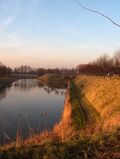
|
The old town is still surrounded by a rampart and a moat. Several remnants of outer works, such as ravelins and an outer wall, remain. |
| IJzendijke | Zeeland | One or more individual structures (Bastions, gates, towers, etc.) remain. | 
|
Some fragments of the old moat remain. One ravelin belonging to the old fortifications has been restored | |
| IJsselstein | Utrecht | One or more individual structures (Bastions, gates, towers, etc.) remain. | 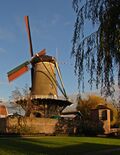
|
The old moat remains, while some remnants of the town wall remain on the south and east side of the old town. | |
| Kampen | Overijssel | One or more individual structures (Bastions, gates, towers, etc.) remain. | 
|
The old moat remains, while the old earthen ramparts remain incorporated in a park. Three medieval city gates remain, two of which have been rebuilt in a renaissance style. The largest gate, the Kroonmarktpoort, retained its medieval appearance. | |
| Klundert | North Brabant | Yes | One or more individual structures (Bastions, gates, towers, etc.) remain. | 
|
Several sections of the ramparts and bastions remain intact to the north and south of the old town. |
| Leerdam | Utrecht | Yes | One or more individual structures (Bastions, gates, towers, etc.) remain. | 
|
The city wall remains intact on the side of the town facing the river Linge. |
| Leeuwarden | Friesland | One or more individual structures (Bastions, gates, towers, etc.) remain. | 
|
The old town is still entirely surrounded by a moat. Several bastions to the north of the old town have been changed into a park. | |
| Leiden | South Holland | One or more individual structures (Bastions, gates, towers, etc.) remain. | 
|
The old city is still surrounded by a moat. Of the city defenses, two city gates remain and one medieval tower stand to the south of the old town. Part of a bastion on the east side of the city has been reconstructed. | |
| Maastricht | Limburg | Yes | Sizable parts of the fortifications remain intact. | 
|
Important parts of all major fortification systems remain intact. Of the first city wall, the Helpoort gate remains, as well as several important sections of the oldest 13th-century city wall. Important parts of the second medieval city wall remain on the east side of the old town, while extensive remnants of the complicated system of baroque fortifications can be found to the north. Additionally, a large network of communication tunnels, casemates, and countermines remain underneath the present outskirts of the city, which were built on top of the old city walls. |
| Megen | North Brabant | One or more individual structures (Bastions, gates, towers, etc.) remain. | 
|
Only a single 14th-century tower, known as the Gevangenpoort, remains. | |
| Middelburg | Zeeland | Yes | One or more individual structures (Bastions, gates, towers, etc.) remain. | 
|
The bastioned trace of the city wall has been changed into a park and is still surrounded by a moat. Only one city gate remains, the 18th-century Koepoort. |
| Montfoort | Utrecht | One or more individual structures (Bastions, gates, towers, etc.) remain. | 
|
One of the medieval city gates has been incorporated into the town hall. Another remaining portion of the town wall remains to the south west of the old town. | |
| Muiden | North Holland | Yes | Sizable parts of the fortifications remain intact. | 
|
The 16th-century town walls were greatly adapted in the 19th century, when the town became part of the advanced defenses of Amsterdam. The city walls located to the west of the river Vecht remain intact, as do the walls around the Muiderslot castle. |
| Naarden | North Holland | Yes | The city wall remains intact. | 
|
Naarden is one of the best preserved fortified cities in Europe, featuring a double system of moats and walls, built in the 17th century. The inner wall features numerous tunnels, casemates, and barracks. |
| Nieuwpoort, South Holland | South Holland | Yes | The city wall remains intact. | 
|
The tiny town is entirely surrounded by an earth rampart featuring six bastions and a false bray in front of the curtain walls. The town hall is built over a canal running through the center of town and defends a system of locks with which the land surrounding the fortress could be inundated. |
| Nijmegen | Gelderland | Sizable parts of the fortifications remain intact. | 
|
Sizable parts of the medieval city walls remain to the west and east of the old city. The most notable remnant is the wall, and three towers, located in the Kronenburger park. Of the three towers, the Kronenburger tower is arguable one of the most impressive medieval towers in the Netherlands. | |
| Ootmarsum | Overijssel | Vestiges. | The old town is still fully enclosed bij two ringroads, called the Westwal (Western wall) and the Oostwal (Eastern wall), indicating the trace of the medieval walls. | ||
| Oudeschans | Groningen | Yes | Sizable parts of the fortifications remain intact. | 
|
The walls of the tiny fortified village have been partially demolished, but remain very recognizable. Part of the city walls have subsequently been reconstructed in the 20th century. |
| Oudewater | Utrecht | One or more individual structures (Bastions, gates, towers, etc.) remain. | 
|
The old city is enclosed by a moat. The locations of some of the old bastions and bulwarks are still recognizable in the shape of the moat. | |
| Philippine, Netherlands | Zeeland | Vestiges of the fortifications are visible in the landscape. | 
|
Remnants of bastions, ravelins, and other outworks are clearly distinguishable in the fields surrounding the town. | |
| Ravenstein | North Brabant | One or more individual structures (Bastions, gates, towers, etc.) remain. | 
|
A moat surrounds much of the old town, clearly showing the location of bastions and ravelins. The remnants of two hornworks are visible to the north and south of the old town. The side of the town facing the river Maas features the remnants of two bastions, excavated from the body of the dyke, as well as the single remaining city gate. | |
| Retranchement | Zeeland | Yes | The city wall remains intact. | 
|
Retranchement was built in 1604 AD as an entrenched camp, consisting of two small, square forts, connected by a wall with three bastions. The northern fort no longer exists as it was destroyed in a flood in 1682 AD. |
| Rhenen | Utrecht | One or more individual structures (Bastions, gates, towers, etc.) remain. | 
|
Lowered fragments of the 14th-century city wall can be found to the south of the old town. To the north, a windmill stands on top of a remnant of the wall. On the eastern entrance of the old town, the remnants of a sizable barracane can be found. | |
| Roermond | Limburg | One or more individual structures (Bastions, gates, towers, etc.) remain. | 
|
Several fragments of the medieval city wall remain. The most notable and best preserved remnant is the Rattentoren, a 14th-century round tower standing on the north side of the old town. | |
| Sas van Gent | Zeeland | One or more individual structures (Bastions, gates, towers, etc.) remain. | 
|
Of the once powerful and strategic fortress, very little remains. Most of the fortifications were demolished in 1930. What remains are the remnants of one bastion, upon which the base of an old windmill stands, and the remnants of an old late 17th-century tidal mill, which was built into the fortifications. | |
| Schiedam | South Holland | One or more individual structures (Bastions, gates, towers, etc.) remain. | Parts of the moat remain, including the northern and western part. The famous Schiedam windmills are built on top of the bases of wall towers. | ||
| Schoonhoven | South Holland | Yes | One or more individual structures (Bastions, gates, towers, etc.) remain. | 
|
Only a fragment of the old moat remains on the landward side of the town. On the riverside stands the Waterpoort, the last remaining city gate, with some adjacent stretches of the old town walls. |
| Sittard | Limburg | Yes | Sizable parts of the fortifications remain intact. | 
|
The powerful fortress town was destroyed by French forces in 1677 AD. Sizable remnants of the medieval city wall remain, buried underneath a later earthen rampart which still surrounds most of the old town. |
| Sluis | Zeeland | Yes | The city wall remains intact. | 
|
The old town of Sluis was completely destroyed in the second world war, but he extensive fortification system remained intact and can still be visited today. |
| Sloten | Zeeland | Yes | Sizable parts of the fortifications remain intact. | 
|
The tiny fortress town of Sloten is still mostly surrounded by its ramparts, while the moat still completely encircles the town. Two water gates remain intact at the places where an old canal dissects the town. |
| Steenbergen | North Brabant | Vestiges of the fortifications are visible in the landscape. | 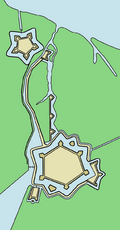
|
Some fragments of the old moat remain. The locations of the old bastions can be recognized by the course of the moat and the street pattern. Remnants of the outer works are distinguishable in the surrounding landscape. | |
| Steenwijk | Overijssel | Yes | Sizable parts of the fortifications remain intact. | 
|
Sizable parts of the moats and ramparts remain. |
| Stevensweert | Limburg | Vestiges of the fortifications are visible in the landscape. | 
|
Although the walls themselves have been demolished, the town was built as an ideal fortress, and features the characteristic spider web street pattern that many such towns were built with. Part of the city walls have been reconstructed from 2007 AD onwards. | |
| Tholen | Zeeland | Yes | One or more individual structures (Bastions, gates, towers, etc.) remain. | 
|
The ramparts were changed into a park, but the moat is still present and four bastions are still recognizable. |
| Tiel | Gelderland | One or more individual structures (Bastions, gates, towers, etc.) remain. | 
|
Fragments of the moat remain, as well as one city gate. | |
| Utrecht | Utrecht | Yes | One or more individual structures (Bastions, gates, towers, etc.) remain. | 
|
The medieval city wall has been completely demolished. Remnants of three of the 16th-century Italian style bastions remain. The most complete bastion is Sonnenborgh. Most of the old city fortifications were changed into an English style landscape park in the 19th century. The Dutch Water Line forms a double ring of fortresses where it passes east of the city. |
| Valkenburg aan de Geul | Limburg | One or more individual structures (Bastions, gates, towers, etc.) remain. | 
|
Two city gates remain at the foot of the ruined castle. Part of the city wall remains to the west side of the old town. The small Den Halder castle was built around an old tower of the city wall. | |
| Veere | Zeeland | Yes | Sizable parts of the fortifications remain intact. | 
|
The Campveerse toren is a large medieval tower that still guards the entrance to the old harbor today. The later earth ramparts remain mostly intact, especially the enlargements built by order of Napoleon |
| Venlo | Limburg | One or more individual structures (Bastions, gates, towers, etc.) remain. | 
|
Nearly nothing remains of the once extensive fortifications of Venlo. The most extensive remnant being a stretch of 14th-century wall known as the "Luif" | |
| Vianen | Utrecht | One or more individual structures (Bastions, gates, towers, etc.) remain. | 
|
The Lekpoort is the last remaining city gate of the little town of Vianen. Apart from the gate, a large part of the town is still enclosed by a moat, while a sizable length of (lowered) city wall still stands on the south side of the town. | |
| Vlissingen | Zeeland | Yes | One or more individual structures (Bastions, gates, towers, etc.) remain. | 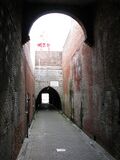
|
Several remnants of bastions, curtain walls and a tower of a medieval city gate, still stand on the waterside. The landward facing defenses have all been demolished. |
| Wageningen | Gelderland | One or more individual structures (Bastions, gates, towers, etc.) remain. | 
|
The foundations of a small stretch of the medieval city wall have been unearthed and restored. Of the later ramparts, the moat remains, its trace clearly showing the locations of the old bastions. | |
| Weesp | North Holland | Yes | The city wall remains intact. | 
|
Only four of the planned eight bastions were constructed. All four remain intact and surrounded by a moat. In the 19th century, a circular fort was constructed on an island in the river Vecht. |
| Willemstad | North Brabant | Yes | The city wall remains intact. | 
|
In 1583 AD, prince William of Orange orders the construction of a fortified city on the location of the village of Ruigenhil. The city, called Willemstad, is still entirely surrounded by its seven sided city wall. |
| Wijk bij Duurstede | Utrecht | One or more individual structures (Bastions, gates, towers, etc.) remain. | 
|
A portion of the moat remains, as do several fragments of the city wall facing the riverside. One city gate still stands as a windmill has been built on top of it. The ramparts that surround the ruins of Duurstede castle have been reshaped into a landscape style park. | |
| Woerden | Utrecht | Yes | One or more individual structures (Bastions, gates, towers, etc.) remain. | 
|
Sizable sections of the inner and outer moats still remain and several of the bastions are still recognizable as such. The medieval castle still stands on the south eastern side of the old town. |
| Woudrichem | North Brabant | Yes | The city wall remains intact. | 
|
The city received a set of strong ramparts with seven bastions in 1580 AD. Only one of the gates, the Gevangenpoort, now remains |
| Zaltbommel | Gelderland | Yes | Sizable parts of the fortifications remain intact. | 
|
The earthen ramparts and its bastions were made into an English landscape park in the 19th century, but the structures remain intact up to a significant height and are easily recognizable. The outer moat still encloses the landward side of the city. Behind the earthen ramparts stand several sizable fragments of the medieval city wall. |
| Zierikzee | Zeeland | Yes | One or more individual structures (Bastions, gates, towers, etc.) remain. | 
|
A moat still surrounds the old town. While the walls have been demolished, three medieval gates remain. Of these gates, the ensemble of the Noordhavenpoort and Zuidhavenpoort, which guard the entrance to the old harbor, form one of the most impressive remaining medieval defensive structures in the Netherlands |
| Zutphen | Gelderland | One or more individual structures (Bastions, gates, towers, etc.) remain. | 
|
Remnants of moats from the medieval and post-medieval fortifications are still visible around the old town. The remnants of the medieval fortifications include several towers, the impressive Drogenapstoren gate, the Bourgonjetoren bastion, a water gate named Berkel gate, and a sizable stretch of the old city wall to the south of the old town. | |
| Zwolle | Overijssel | One or more individual structures (Bastions, gates, towers, etc.) remain. | 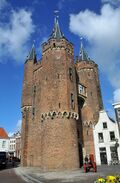
|
The moat, still clearly showing the remnants of the old bastions, still encloses the old town. The Sassenpoort is the sole remaining city gate, but is one of the largest and most impressive gates of the Netherlands. A number of fragments of the medieval city wall, including two strong towers, still stand along the waterside of the Thorbeckegracht |
Norway
- Fredrikstad
- Gamlebyen
- Oslo (Akershus Fortress)
Poland



- Biała
- Białogard
- Bolesławiec – the old town has fragmentary remains of the old town wall, including several towers and stretches of wall.
- Braniewo
- Brodnica
- Brzeg – a star-shaped park around the old town is what remains of the renaissance fortifications. Some parts of the moat still remain. The shape of seven bastions is recognizable from the air.
- Bystrzyca Kłodzka
- Chełmno – almost whole length of walls (2.2 km), with 17 watch towers and city gate, 13th and 14th centuries.
- Chojna
- Chojnice
- Dąbie
- Dzierżoniów
- Gdańsk
- Głogów
- Gniew
- Goleniów
- Golub-Dobrzyń
- Gorzów Wielkopolski
- Grodków
- Grudziądz
- Gryfice
- Gryfino
- Jawor
- Jelenia Góra
- Kalisz
- Kamień Pomorski
- Kętrzyn
- Kłodzko – the remains include the impressive citadel located on a hill north of the medieval town.
- Kołobrzeg – a round basion and a part of the moat still remain.
- Kostrzyn – the medieval town was entirely destroyed during World War II, only remaining some ruins of houses, the ruins of a church and the riverside fortified walls. The fortified walls include three bastions and a land gate. The remaining moat of an outer work is located north west of the ruined medieval town.
- Koszalin
- Kowalewo Pomorskie
- Kożuchów
- Kraków – only the barbican, Floriańska Gate, two watch towers and some traces preserved
- Krapkowice
- Kwidzyn
- Legnica
- Lębork – city ruins from the Medieval era
- Lidzbark Warmiński
- Lipiany
- Lubań – partially preserved
- Lubawa
- Lubin
- Lublin
- Malbork – one gate and a round bastion still remain. Stretches of the walls still remain alongside the river in the direction of the famous Malbork Castle
- Maszewo – the town walls are nearly complete, apart from two breaches made for the increasing traffic. The two original town gates are demolished, and an adjacent tower of one of the gates still remains.
- Mieszkowice
- Modlin Fortress
- Myślibórz
- Nowe – sizable parts of the walls remain.
- Nowe Miasto Lubawskie – two town gates remain.
- Nowogrodziec
- Nysa – there are large remains of the renaissance fortifications, notably to the east of the old town and to the north of the Nysa Klodzka river. There are several forts around Nysa. The remains of the medieval town walls include two land gates, the remains of a water gate, some towers and stretches of wall.
- Olkusz
- Olsztyn
- Opole – the remaining walls are located in the north east corner of the medieval town.
- Paczków – very well preserved walls with 19 towers and 3 gates
- Pasłęk – large stretches of the walls remain intact, including two city gates
- Poznań – city walls existed until the early 19th century (fragments remain); Prussian fortifications were built in the 19th century
- Prabuty
- Prudnik – three watch towers
- Przemyśl – partially preserved ruins
- Pyrzyce – until World War II best preserved city walls in Pomerania region, from the 14th century
- Sandomierz
- Słupsk
- Stargard – significant parts survived with 3 gates (including unique water gate – Brama Młyńska); one of the most interesting city walls in Poland
- Starogard Gdański
- Strzegom
- Strzelce Krajeńskie
- Sulechów
- Susz
- Syców
- Szczecin – to the east of the castle remains a well-preserved wall tower. Two town gates still remain.
- Szprotawa
- Szydłów – city walls with Krakowska Gate and watch towers built in the 14th century
- Środa Śląska
- Świebodzice
- Świebodzin
- Tarnów
- Tczew
- Toruń – several watch towers, three city gates and some sections (the longest and most impressive from Vistula) from the 13th to 15th centuries
- Trzcińsko-Zdrój
- Trzebiatów
- Warsaw – partially preserved, partially restored after World War II, barbican restored
- Wieluń
- Wolin – only one bastion remains to the south of the town.
- Wrocław
- Ząbkowice Śląskie
- Zamość – complete renaissance and 19th-century walls preserved
- Złotoryja
- Żagań
- Żary
Portugal
- Almeida Vauban style fortress town.
- Avis (or Aviz)
- Beja
- Bragança – the old town is still completely surrounded with medieval walls, including all 12 towers and two gates.
- Caminha
- Castelo Branco
- Castelo de Vide
- Chaves
- Coimbra
- Évora
- Elvas – Elvas is among the finest examples of intensive usage of the trace italienne (star fort) in military architecture.
- Estremoz
- Guarda
- Guimarães
- Lagos, Portugal
- Lisboa, Portugal – There are fragments of a Fernandin Wall since the 13th century.
- Marvão
- Monção
- Monsaraz
- Monforte
- Óbidos
- Olivenza
- Peniche
- Santarém
- Setúbal – the remains of 5 bastions can be found around town.
- Valença
- Vide
- Vila Viçosa
Romania

روسيا
- أسوار المدينة
- ديربنت (موقع تراث عالمي)
- إيزبورسك
- موسكو (تم تفكيك أسوار بيلوي جورود، كما تم تفكيك معظم سور كيتاي-غورود)
- بسكوڤ
- سمولينسك
- فيبورغ (لا يزال هناك برجان من السور القديم، بالإضافة إلى باستيون واحد على جانب ومجموعة كاملة من التحصينات الباستيونية على الجانب الآخر)
- ياروسلافل (لا تزال عدة أبراج قائمة)
- نوفوكوزنيتسك
- غوروديتس
- الكرملين (الحصون)
- لادوغا
- سفيياجسك
- أستراخان
- إيفانغورود
- قازان
- كولومنا
- موسكو
- نيجني نوفغورود
- نوفغورود
- بورخوف
- توبولسك
- تولا
- زارايسك
- كورلا
- روستوف
- بيلووزيورسك
- سوزدال
- دميتروف
- موزهايسك
- غدوف
- أوغليتش
- يورييف-بولسكي
- فيليكي لوكي
- يام
- فيرخو-توريا
- سيربوخوف
- ألكسندروف
- سوزران
- فييزما
- فولوغدا
- فولوكاملسك
- فلاديمير
- زفينيجورود موسكوفسكي
- ريازان
- بيرياسلافل زاليسكي
- بريانسك
- إيركوتسك
Serbia
- Belgrade – Kalemegdan
- Novi Sad – Petrovaradin
- Bač
- Manasija – Resava
- Niš
- Pirot
- Smederevo
- Golubac
- Maglič
- Šabac
سلوفاكيا


- بانسكا بيستريتسا
- بانسكا شتيافنيتسا – تبقت بوابة واحدة فقط من المدينة.
- باردييوف – الأسوار محفوظة تقريبًا بالكامل، مع الباستيونات وباربيكان.
- بيكوف
- بوجنيتسه – أجزاء كبيرة من السور محفوظة، مع إحدى بوابات المدينة.
- براتيسلافا – بقيت هياكل قليلة من التحصينات الأصلية.
- بريزنو
- فيلاكوفو
- كومارنو – تحصينات باروكية محفوظة بالكامل تقريبًا.
- كوشيتسه
- كيجماروك
- كرمنيتسا – حوالي ثلثي الأسوار الدفاعية المحيطة بالمدينة محفوظة، مع عدة باستيونات وبوابة المدينة مع باربيكان.
- كرابينا
- ليفيتسه – تم العثور على أجزاء من الأسوار الدفاعية خلال المسوحات الأثرية.
- ليفوتشا – محفوظة تقريبًا بالكامل.
- مودرا – حوالي ثلثي الأسوار لا تزال قائمة، مع باستيون واحد وإحدى بوابات المدينة.
- نوفي زامكي
- بيزينوك – أجزاء من الأسوار الدفاعية مرئية في عدة مواقع من المدينة.
- بودولينيتس
- بوكانيتس
- بريشوف – تم العثور على أجزاء من الأسوار الدفاعية خلال المسوحات الأثرية.
- سابينوف
- سكاليكا – أجزاء كبيرة محفوظة.
- سبشسكا كابيتولا
- سفاتى يور
- ترنتشين – تم العثور على أجزاء من الأسوار الدفاعية خلال المسوحات الأثرية.
- ترنافا – محفوظة في الغالب، مع عدة باستيونات وبوابة مدينة واحدة.
- زفولين
- جيلينا
Slovenia
- Celje
- Koper
- Kranj – evidence of the 1st-century fortifications and parts of the medieval fortifications, with four of the original eight towers preserved
- Ljubljana – In the 1st century AD, a Roman settlement called Emona, on the site of the present-day Ljubljana, was fortified with strong walls. A small section of the southern wall is still preserved to this day. Ljubljana got its medieval walls, like many other towns in Slovenia, in the 13th century
- Maribor – Originally 13th-century fortifications, rebuilt several times until the 17th century; some segments, including three towers and two bastions, are still preserved. Withstood sieges by Matthias Corvinus in 1480/1481 and by the Ottoman Empire in 1532.
- Novo Mesto
- Piran – 7th-century fortification, expanded between 1470 and 1533
- Ptuj – 13th-century fortification
- Slovenj Gradec
- Škofja Loka
- Vipavski Križ
إسبانيا
- لاكورونيا – بقايا متفرقة و3 بوابات
- آينسا
- ألاركون
- ألباراسين
- ألبوكيرك
- ألكالا دي إيناريس – حافظت على 1,200 متر من الأسوار مع 19 برجًا
- ألكانتارا
- ألكوديا
- ألمازان
- ألكيزار
- أرتاخونا
- أستورجا
- أتيينزا
- أفيلا – تحتوي على أكثر الأسوار اكتمالًا من العصور الوسطى في إسبانيا، ويمكن السير على نصفها.
- باداخوث – تحتوي على أسوار من العصور الوسطى وأغلب حصن النهضة.
- بالاغوير
- برشلونة – تحتوي على أجزاء من جدار روماني.
- بيخار
- برلانجا دي دويرو
- بيسالون
- بريويغا
- بويتراجو ديل لوزويا – تمتلك أسوارًا من العصور الوسطى كاملة.
- برغش – تحتوي على أجزاء كبيرة من أسوار المدينة بجانب Paseo Cubos والشمال الشرقي من القلعة، بما في ذلك 10 أبراج جدارية. تحتوي أيضًا على 5 بوابات، مثل Arco de Santa Maria وArco de San Martin.
- برغو دي أوسما
- كاسيريس
- كامبو مايور
- قرطاجنة
- كاستيلار دي لا فرونتيرا
- سيديرا – بقايا متفرقة.
- سبتة
- ثيوداد رودريغو – عانت من عدة حصارات في الحروب النابليونية، لكن الأسوار ما زالت سليمة.
- ثيوداديلا دي مينوركا
- كوكا
- قرطبة
- كوريا – المدينة القديمة محاطة بالكامل بأسوار من العصور الوسطى والرومانية.
- كوفاروبياس
- كويا
- كوينكا
- داروكا
- فرياس
- غاليسيو – أسوار المدينة محفوظة بالكامل.
- خيخون
- جيرونا
- غرناطة
- زارزا دي غرناadilla
- هازا
- هنداربيّا
- هويسكا – بقايا متفرقة.
- إيبيزا
- خيريث دي لوس كاباليروس
- لاجوارديا
- لاردو – لا تزال بوابتان قائمتان: Puerta de Merenillo وPuerta de Bilbao.
- يانيس
- ليون – تمتلك مجموعة شبه مكتملة من الأسوار الرومانية التي تعود إلى القرن الثالث الميلادي، بالإضافة إلى أجزاء من العصور الوسطى.
- لواري
- لوغو – تمتلك أسوارًا رومانية مكتملة تمامًا وهي محمية من قبل اليونسكو كموقع تراث عالمي.
- ماديرويلو
- أسوار مدريد – تشمل خمس أسوار.
- مدريغال دي لاس ألتاس توريس
- مالقة
- مانسيلا دي لاس مولاس
- مانسانيدا – بقايا من السور، بما في ذلك إحدى البوابات الثلاث.
- مدينة دل كامبو – بقايا متفرقة.
- مليلية – المدينة القديمة محاطة بالكامل بأسوار العصور الوسطى.
- ميرامبيل
- مولينا دي أراغون
- مونفورتي دي ليموس – تم الحفاظ على معظم أسوار المدينة التي تعود إلى القرن الثالث عشر، بما في ذلك بوابتان.
- مونتبلانك
- موريّا
- نيبلا
- أوليفنزا – الجزء الأقدم من المدينة يحتوي على أسوار وأبراج محفوظة جيدًا.
- أوفييدو – حافظت على أجزاء من أسوارها.
- بنبلونة
- شقوبية – أجزاء محفوظة من السور مع ثلاث بوابات.
- طليطلة
- فالنسيا – أجزاء محفوظة من سور إسلامي وأبراج من العصور الوسطى.
- بلد الوليد
- سمورة – لا تزال أسوار المدينة القديمة محفوظة بشكل كبير.
- سرقسطة
Sweden
- City wall of Visby
- Gothenburg has a part of the western city wall left, the bastion Carolus Rex at Esperantoplatsen (Esperanto square) and most of the city moat is still left.
- Halmstad had renaissance ramparts. To the north of the old town a bastion with adjacent town gate remains, the Norre Port. To the south of the old town a bastion with a remnant of the moat remains.
- Kalmar substantial remains of the walls. Sizable stretches of walls and a bastion remain to the south of the old town. To the east remain two bastions. To the north remain portions of wall near Fiskaregatan. To the west the shape of two bastions is clearly recognizable, with a ravelin in front of the remaining town gate Westport (Westgate). Two other town gates still remain, an unmanned gate of later date at the Skeppsbrogatan, and a gate at Skeppsbron.
- Stockholm has a small remainder of the medieval city wall preserved.
- Bohus Fortress
Switzerland
- Aarau – the remains of the medieval town walls include two town gates (the Haldertor and the Oberer Turm) and a tower (the Pulverturm) with an adjacent stretch of wall.
- Altstätten
- Arbon – the remains include some fragments of wall and a tower converted into a house.
- Avenches
- Baden
- Basel
- Bellinzona (Dominated by its three castles: Castelgrande, Castello di Montebello and Castello di Sasso Corbaro)
- Biel
- Bremgarten
- Brugg
- Bülach
- Chur
- Delémont
- Diessenhofen
- Frauenfeld
- Fribourg
- Geneva
- Greifensee
- Grüningen
- Gruyères
- Ilanz
- Laufen
- Lausanne
- Lenzburg
- Liestal – one town gate remains.
- Lucerne – the wall on the northern bank of the Reuss is well preserved and among the principal landmarks of the city. It is called Museggmauer and Stadtmauer.
 The late medieval walls of Lucerne, called Museggmauer or Stadtmauer.
The late medieval walls of Lucerne, called Museggmauer or Stadtmauer. - Maienfeld
- Meienberg, Sins, Aargau
- Morges
- Münchenstein
- Murten: Medieval walls
- Neuchâtel
- Nyon
- Olten
- Orbe
- Rapperswil
- Regensberg
- Rheinfelden
- Romont
- Schaffhausen
- Sempach
- Solothurn – large parts still remain, including several walls, towers and a bastion. Two town gates remain, the impressive Baseltor and the Bieltor.
- Steckborn
- Sursee
- Thun
- Uznach
- Wangen an der Aare
- Werdenberg
- Wiedlisbach
- Willisau
- Winterthur
- Yverdon-les-Bains
- Zofingen
- Zug – the only remainder of the inner town walls is the Zeitturm (Clocktower), a medieval town gate. The remains of the outer town walls include four towers (the Kapuzinerturm, Knopfliturm, Huwilerturm and the Pulverturm), and some stretches of wall.
- Zürich – the main remains are the Schanzengraben, and the shapes of several bastions are recognizable through the course of the moat. One bastions remains largely intact, and it now houses the Alter Botanischer Garten.
تركيا

- طروادة. كانت مدينة طروادة القديمة مشهورة بأسوارها الدفاعية. هناك أدلة أثرية تشير إلى أن طروادة السابعة، والتي تُعتبر عمومًا المرحلة المرتبطة بـ حرب طروادة الأسطورية التي وردت في ملحمة الإلياذة لـ هوميروس، والمُؤرخة عادة بين 1194 ق.م و1184 ق.م، كانت تحتوي على أسوار ذات أساس حجري متين يبلغ سمكه أكثر من أربعة أمتار وارتفاعه حوالي تسعة أمتار في بعض الأماكن، topped by a larger superstructure made of mudbrick with towers. في ملحمة هوميروس، كانت الأسوار قوية لدرجة أن حصار طروادة من قبل الآخيين استمر أكثر من تسع سنوات ولم ينتهِ إلا بحيلة حصان طروادة. لا تزال أجزاء من الأساس الحجري لأسوار طروادة قائمة في الموقع الأثري الحالي في حصارليك، في محافظة جناق قلعة.
- إسطنبول. نظام الأسوار المحيطة بـ القسطنطينية (كما كان يُطلق عليها آنذاك) الذي بُني عام 412 على يد الإمبراطور الروماني ثيودوسيوس الثاني كان حاجزًا حجريًا معقدًا امتد على مسافة 6.5 كيلومترًا، ويُعرف عادة بـ أسوار ثيودوسيوس. صمد هذا الحاجز ضد عدة حصارات عنيفة لمدة عشرة قرون حتى عام 1453 عندما نجح العثمانيون في اختراقه. كان هناك عنصر جديد في ساحة المعركة: جيش العثمانيين كان يمتلك مدفع البارود، بينما قدمت الأسوار مقاومة محدودة لهذه القوة النارية.
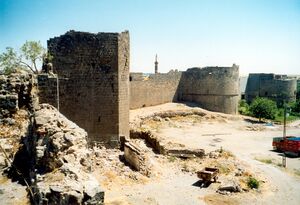
- ديار بكر. تحيط بـ ديار بكر مجموعة شبه متكاملة من الأسوار العالية المصنوعة من البازلت الأسود، والتي تشكل دائرة بطول 5.5 km (3.4 mi) حول المدينة القديمة. تحتوي الأسوار على أربع بوابات و82 برجًا للمراقبة. بُنيت الأسوار في العصور القديمة وتم ترميمها وتوسيعها على يد الإمبراطور الروماني قسطنطيوس عام 349.
- أنقرة
- جناق قلعة
- إزنيق
- أنطاليا
- سينوب
- ريزا
- أماسيا
- بودروم
- ألانيا
- آني
- كوشاداسي
- برغاما
- أسوس
- بوزجادا
- أدرنة
- طرابزون. لا تزال معظم أسوار المدينة قائمة وتُعد من أقدم المباني في المدينة. يمكن تأريخ أقدم أجزائها إلى القرن الأول الميلادي خلال عصر الإمبراطورية الرومانية. توفر المصادر التاريخية معلومات حول المراحل الأقدم من بنائها. ذكر زينوفون، الذي زار المدينة في القرن الخامس قبل الميلاد، وجود أسوار المدينة.
- إينيز
- بورصة
- سيغاجيك
```
أوكرانيا
- أسوار المدينة
- بيلهورود دنيستروفسكي (انظر قلعة أكيرمان)
- تشرنيهيف (لم يبقَ سوى أنقاض تحت الأرض)
- كروبيفنيتسكي (بقيت أجزاء صغيرة من قلعة سانت إليزابيث)
- كييف (انظر البوابة الذهبية)
- لفيف (انظر بوابة غلينياني والقلعة العليا في لفيف)
- القلعات والقلاع
- لوتسك (انظر قلعة لوبرت)
- كاميانيتس بوديلسكي (انظر قلعة كاميانيتس بوديلسكي)
- كريمنيتس (انظر قلعة كريمنيتس)
- خوتين (انظر قلعة خوتين)
- خوست (انظر قلعة خوست)
- مانغوب
- مدجبيج (انظر قلعة مدجبيج)
- موكاتشيفو (انظر قلعة بالانوك)
- ستاري سيلو (انظر قلعة ستاري سيلو)
- سوداك
- أوجهورود (انظر قلعة أوجهورود)
- يني-قلعة
المملكة المتحدة
إنجلترا
| المكان | المقاطعة | الحالة | الصورة | الملاحظات |
|---|---|---|---|---|
| ألنيك | نورثمبرلاند | تصنيف "الدرجة الأولى" يشمل بوابة بوندغيت (بوابة هوتسبير) وجزء من الجدار المتبقي من التحصينات العائدة للعصور الوسطى. برج بوترغيت أعيد بناؤه في القرن الثامن عشر وقد يحتوي على أجزاء أصلية. | 
|
|
| باث | سومرست | توجد عدة أجزاء من الجدار تعود للعصور الوسطى، بما في ذلك البوابة الشرقية التي تبقى الوحيدة من بوابات المدينة الأصلية. | 
|
تم إعادة بناء جزء كبير من الجدار مقابل مستشفى المياه المعدنية، ويعتبر الطول الباقي الذي كان يبلغ 160 قدمًا أفضل جزء قبل دفنه تحت أرضية متجر جديد عام 1963. |
| بيريك أبون تويد | نورثمبرلاند | تظل التحصينات الإليزابيثية، مع الباستيونات والبوابات والأرضيات الترابية، قائمة. | 
|
يُعتقد أن "سبيدز مير" عبارة عن خنادق دفاعية ربما كانت تشكل خطًا دفاعيًا خارجيًا للمدينة في العصور الوسطى. |
| تشستر | تشيشاير | الجدران في الغالب سليمة. | 
|
تعتبر جدران مدينة تشستر من أبرز المعالم السياحية. بُنيت في الأصل على يد الرومان وتشكل حلقة كاملة حول معظم وسط المدينة اليوم. |
| يورك | شمال يوركشاير | جدران المدينة واسعة النطاق وتعتبر الأطول والأكمل في إنجلترا، مع وجود بعض الأقسام القصيرة المفقودة. | 
|
تفتقر فقط إلى أقسام قصيرة ومعظم بوابات المشاة. |
أيرلندا الشمالية
| المكان | المقاطعة | الحالة | الصورة | الملاحظات |
|---|---|---|---|---|
| بانغور | مقاطعة داون | |||
| كاريكفرغس | مقاطعة أنترم | تبقى فقط أجزاء صغيرة من الجدران. | ||
| ديري | مقاطعة لندنديري | الجدران مكتملة تمامًا. | 
|
جدران مدينة ديري اكتملت عام 1619، وكانت آخر مدينة مسورة بُنيت في أوروبا. لم تُخترق الجدران خلال عدة حصارات، بما في ذلك حصار ديري عام 1689، ولهذا أُطلق عليها لقب "المدينة العذراء". |
اسكتلندا
| المكان | الحالة | الصورة | الملاحظات |
|---|---|---|---|
| دندي | تبقى قسم واحد فقط من جدران المدينة. | 
|
بُنيت لأول مرة عام 1545، وتشمل قوس ويشارت. |
| إدنبرة | بقايا من الجدار الفلوديني في القرن السادس عشر والجدار التيلفري في القرن السابع عشر لا تزال قائمة. | 
|
الجدران الأولى بُنيت في القرن الثاني عشر، ولكن لم يبقَ أي أثر منها اليوم. |
| ستيرلينغ | توجد 5 أجزاء بارزة من جدار البلدة العائد للقرن السادس عشر، بما في ذلك باستيونان دفاعيان. | 
|
تم بناء الجدران بارتفاع 7 أمتار وسماكة 1.8 متر للدفاع عن المداخل الجنوبية والغربية للمدينة. |
ويلز
- أبيريستويث
- بيوماريس
- بريكون
- كيرليون (Isca Augusta)
- كيروينت (Venta Silurum)
- كايرنارفون
- كارديف
- كاردجن
- تشبستو – جدار الميناء
- كونوي
- تينبي
- بمبرك
- رادنور القديمة
```
Vatican City
انظر أيضاً
References
- ^ "12 Impressive Walled Cities in the World". Retrieved 9 December 2012.
- ^ أ ب "Discovering the secret city from the 1700s under Halifax". CTV Atlantic. BellMedia. 30 April 2019. Retrieved 9 July 2020.
- ^ "Le Bourg des Trois Rivières".
- ^ "Defenses – History – Colony of Avalon". www.heritage.nf.ca.
- ^ "Baluarte de Santiago". Fodor's. Retrieved 30 October 2009.
- ^ Castillero, Alfredo (2004). UNESCO Guides: Panamá la Vieja and Casco Viejo. UNESCO Publishing. ISBN 92-3-103923-7.
- ^ "St. Augustine Town Plan Historic District-American Latino Heritage: A Discover Our Shared Heritage Travel Itinerary". Nps.gov. Retrieved 2018-09-16.
- ^ "New Orleans before the battle The Battle of New Orleans December 1814 – January 8, 1815". battleofneworleans.org. Retrieved 2016-09-04.
- ^ Administration, Works Progress (2011-08-15). New Orleans City Guide (in الإنجليزية). Garrett County Press. ISBN 9781891053405.
- ^ "The Dutch & the English, Part 2: A Wall by Any Other Name". NYC Department of Records & Information Services (in الإنجليزية الأمريكية). February 23, 2017. Retrieved January 17, 2023.
- ^ Institute of Taiwanese History, Academica Sinica. "清代臺灣城郭". 台灣歷史文化地圖.
- ^ Seka Brkljača (1996). Urbano biće Bosne i Hercegovine (in صربية-كرواتية). Sarajevo: Međunarodni centar za mir, Institut za istoriju. p. 27. Retrieved 28 October 2021.
- ^ "The natural and architectural ensemble of Stolac". UNESCO World Heritage Centre (in الإنجليزية). Retrieved 28 October 2021.
- CS1 الإنجليزية الأمريكية-language sources (en-us)
- CS1 صربية-كرواتية-language sources (sh)
- Short description is different from Wikidata
- Incomplete lists
- Articles with hatnote templates targeting a nonexistent page
- Articles with unsourced statements from September 2022
- City walls
- Lists of buildings and structures
- Fortified settlements
